Famous protests in US history and their impacts
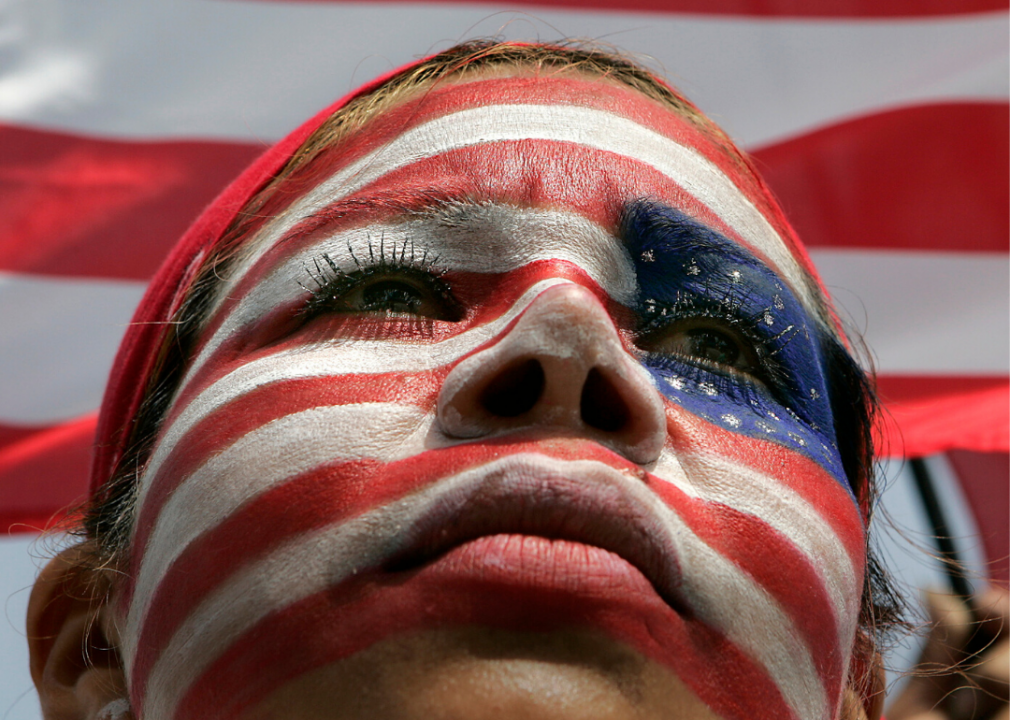
Robert Gauthier/Los Angeles Times via Getty Images
Famous protests in US history and their impacts
On Oct. 21, 1967, 100,000 people came together at the Lincoln Memorial in Washington D.C. to protest the Vietnam War. Following several speeches, roughly 50% of those gathered walked over to the Pentagon where a few hundred people then attempted to levitate the building.
The striking civic protest against the Vietnam War was noteworthy not just for its unusual call to action, but for the new and inventive ways Americans were flexing their right to peaceably assemble. And the Yippies who put on the event inspired countless creative takes on what protest could be, from the Women’s Art Movement (WAM) to the AIDS Coalition to Unleash Power (ACT UP).
The tradition of protesting in the United States is older than the country itself. We’ve seen that historic institution in full force with Black Lives Matter protests and, more generally, protests against the storied, systemic racial injustice in the United States. The May 25, 2020, death of George Floyd, a Black man, held under the knee of a white police officer in Minneapolis, sparked protests across U.S. cities and around the world. The protesters called for justice for Floyd and other Black people—from Breonna Taylor to Elijah McClain—who were killed by police, an end to police brutality, a dismantling of racist systems and symbols (including memorials to Confederate soldiers), and a greater investment in communities in need.
The protests prompted widespread dialogue about racial injustice and the political and cultural systems that support it. The four police officers involved in the killing of Floyd were charged with crimes related to the incident. The Minneapolis City Council agreed to dismantle its police force and rethink how it approaches public safety. And many politicians promised to adjust police budgets so money gets reallocated to support communities directly through improved housing, education, and mental health programs, especially in communities of color.
To understand where the Black Lives Matter demonstrations fit into this rich history, Stacker took a closer look at some of the most famous American protests. Research came from The New York Times, The Week, Time, and Business Insider; government archives; and information from unions and mission-driven organizations. The demonstrations that have made their mark on history range from the Boston Tea Party and Temperance prayer protests to demonstrations for modern-day issues, like civil rights, climate change, nuclear disarmament, reproductive health concerns, LGBTQ+ equality, and gun control.
Keep reading to learn about the important issues that motivated Americans to protest—and the impacts of those actions on our society today.
[Pictured: A portrait taken during The Day Without an Immigrant protest on May 1, 2006.]
You may also like: Political cartoons from the last 100 years
![]()
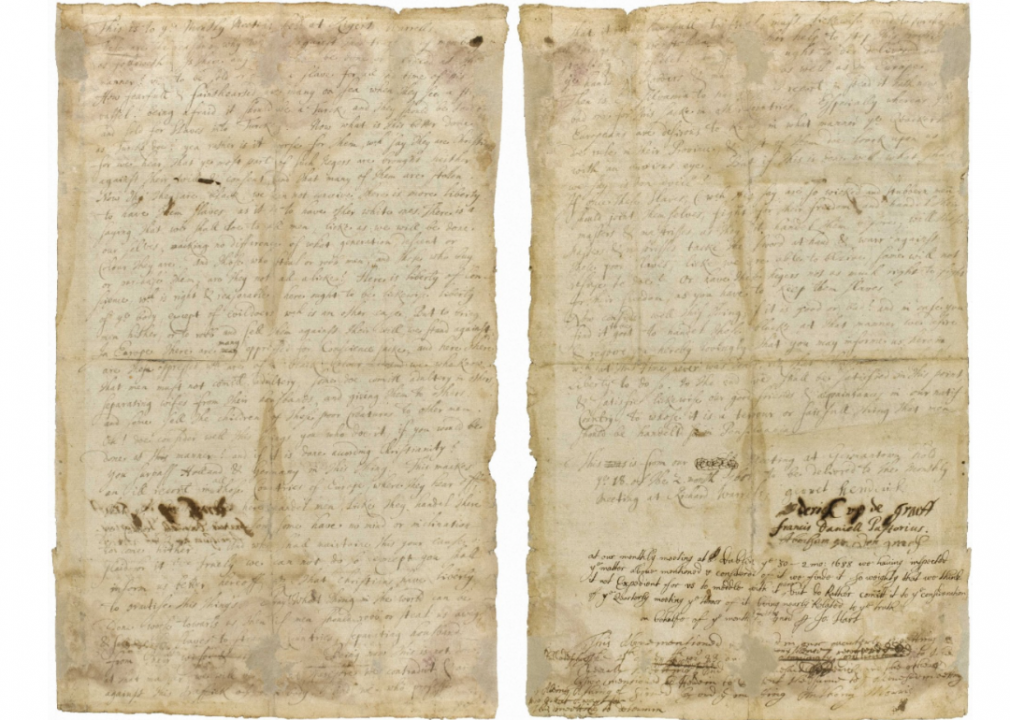
The Germantown Quakers // Wikimedia Commons
1688: Germantown Quaker petition against slavery
A group of Quakers in Germantown, Pennsylvania, in 1688 created the “first written protest against slavery in the new world,” according to the Germantown Mennonite Historic Trust. The group saw the enslavement of others as a contradiction to its religious values and its history of fleeing oppression from the British. Sadly, the petition was not formally accepted by the higher governing bodies of the Quakers, but enslavement was eventually banned within the Quaker community in 1776.
[Pictured: A photograph of the original 1688 Germantown Quaker Petition Against Slavery after restoration in 2007.]
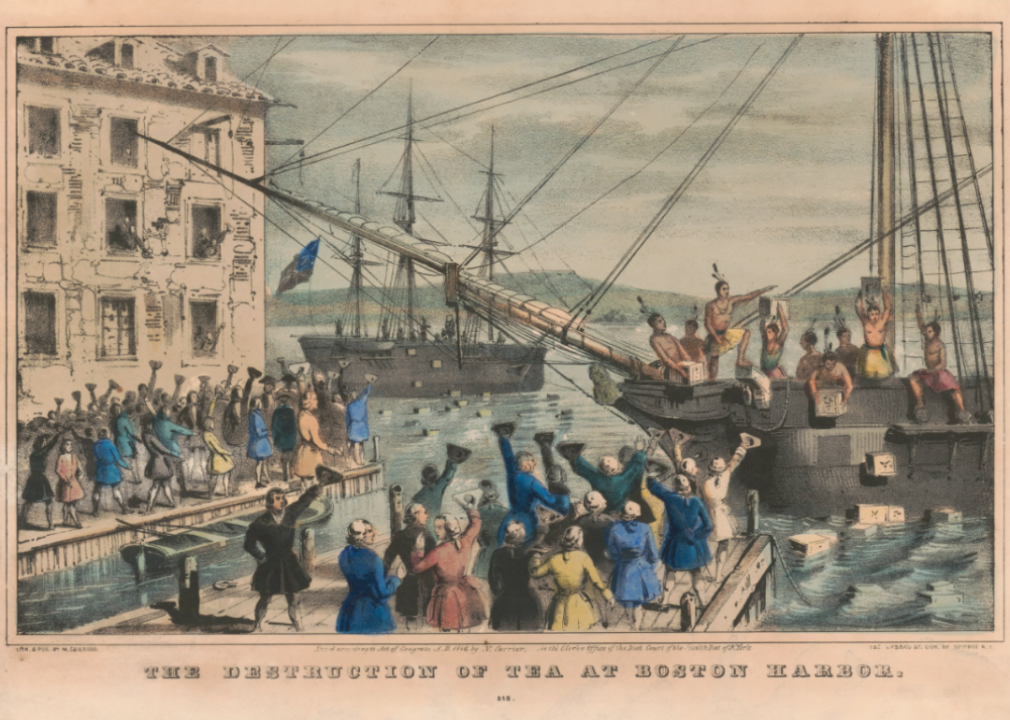
N.Currier // Library of Congress
1773: The Boston Tea Party
Protesters flooded Griffin’s Wharf in Boston on a dreary December evening in 1773 to demonstrate against the Tea Act, which gave the British government an effective monopoly on selling tea in the colonies. People dumped hundreds of chests of tea from the British East India Company into the water—an act of defiance against British rule without representation of the colonists who just two years later would fight in the American Revolution.
[Pictured: A Currier and Ives lithograph showing the destruction of tea in the Boston Harbor.]
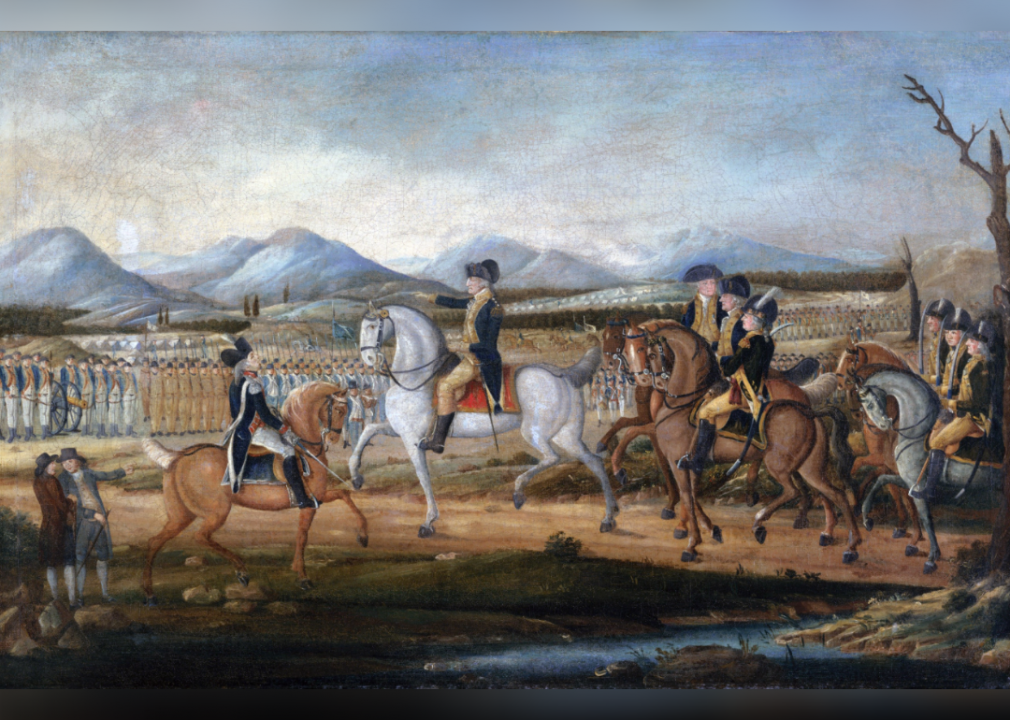
Metropolitan Museum of Art // Wikimedia Commons
1791: The Whiskey Rebellion
Enraged by a new duty on whiskey and distilled spirits implemented in 1791, farmers in Pennsylvania and Virginia used violence and acts of intimidation in attempts to stop the collection of the tax. They justified their tactics with the belief that they were fighting against taxation without representation. President George Washington and his troops headed to the area with the protests to demonstrate the government’s authority to enforce laws.
[Pictured: A painting attributed to Frederick Kemmelmeyer and titled, “The Whisky Rebellion,” depicts George Washington and troops near Fort Cumberland, Maryland.]
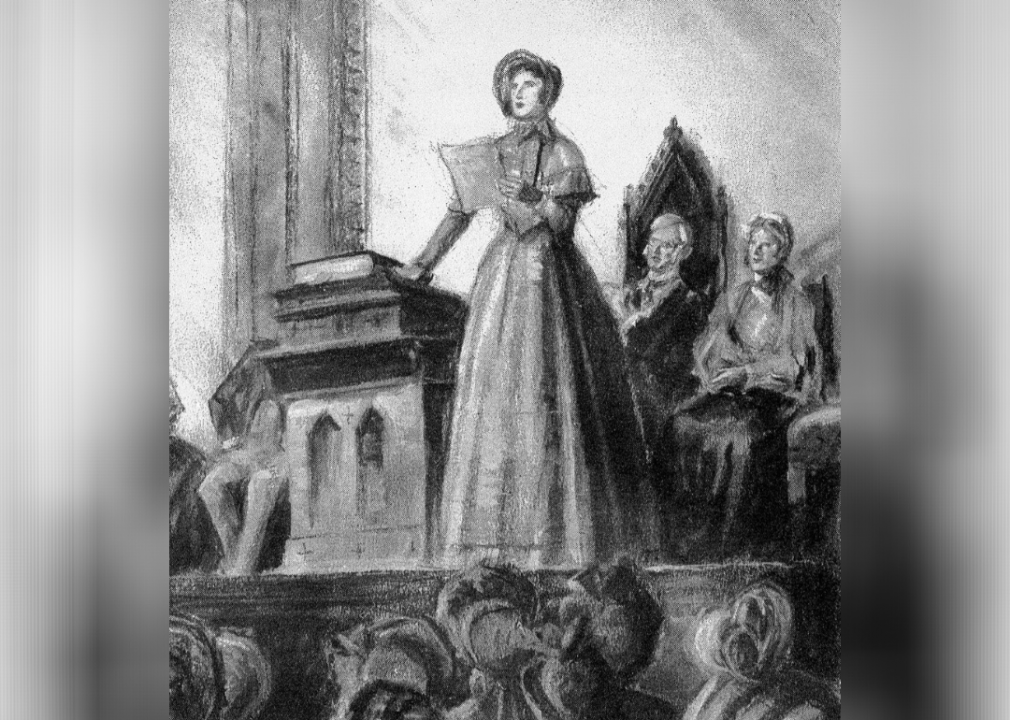
Bettmann // Getty Images
1848: The Seneca Falls Convention
A group of feminists on July 19, 1848, hosted the first women’s rights convention in the United States: the Seneca Falls Convention in Seneca Falls, New York. Around 300 people assembled to protest the government’s unequal treatment of women and to call for women to be granted all the rights and freedoms outlined in the Declaration of Independence. The convention gave the women’s rights movement the momentum it needed to pursue suffrage.
[Pictured: An illustration of Elizabeth Cady Stanton speaking at the Seneca Falls Convention.]
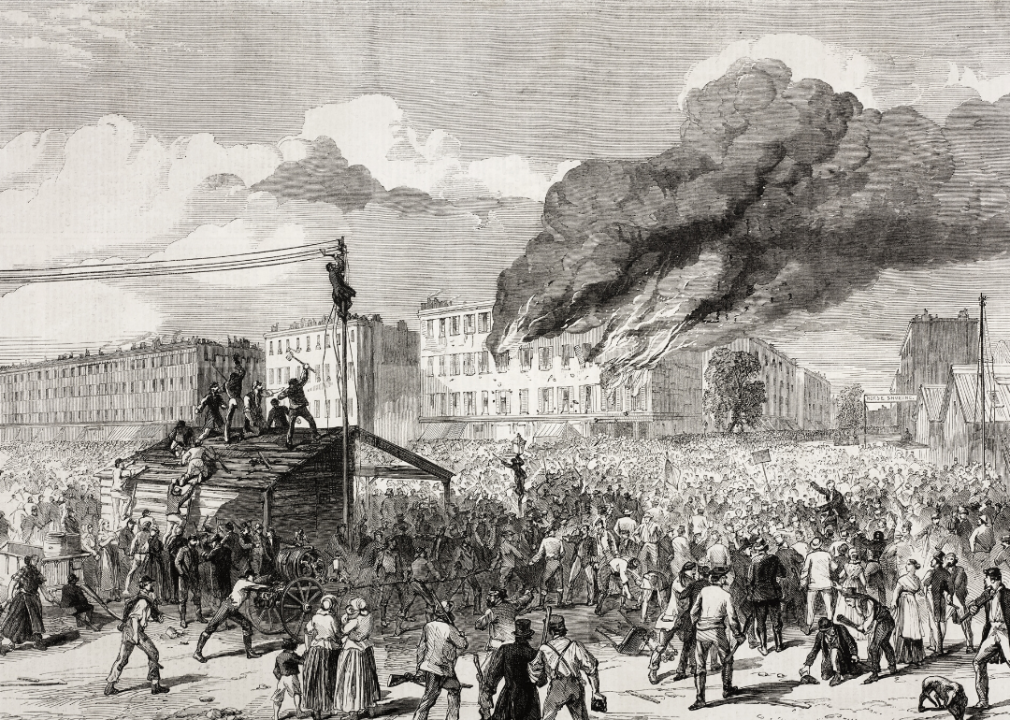
DEA/BIBLIOTECA AMBROSIANA // Getty Images
1863: New York City draft riots
Violent demonstrations erupted in Lower Manhattan from July 13–16, 1863, in response to a decision by Congress to draft men into the Civil War. The protests quickly devolved into a race riot as white protestors (comprised largely of Irish immigrants) began attacking Black people—many of whom ended up permanently moving from Manhattan to Brooklyn.
[Pictured: An illustration shows the Provost Marshal’s office burning during the draft riots in New York City on Aug. 8, 1863.]
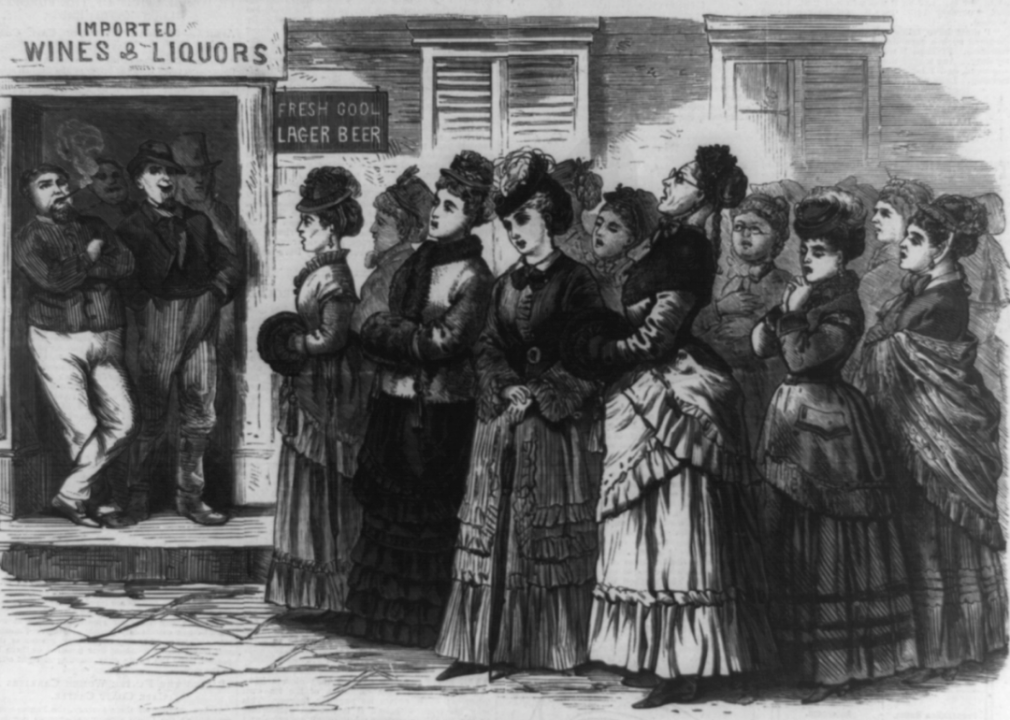
S.B. Morton // Library of Congress
1874: The Women’s Crusade
The Women’s Crusade was a religious, anti-alcohol group. Members of the group protested the sale of alcohol through picketing, marching, and public praying outside of saloons in Ohio, Pennsylvania, New Jersey, Indiana, and Michigan in 1874. The group was the predecessor to the Women’s Christian Temperance Union, which helped pave the way for Prohibition a few decades later.
[Pictured: An 1874 illustration depicts women in Logan, Ohio, singing hymns to aid the temperance movement.]
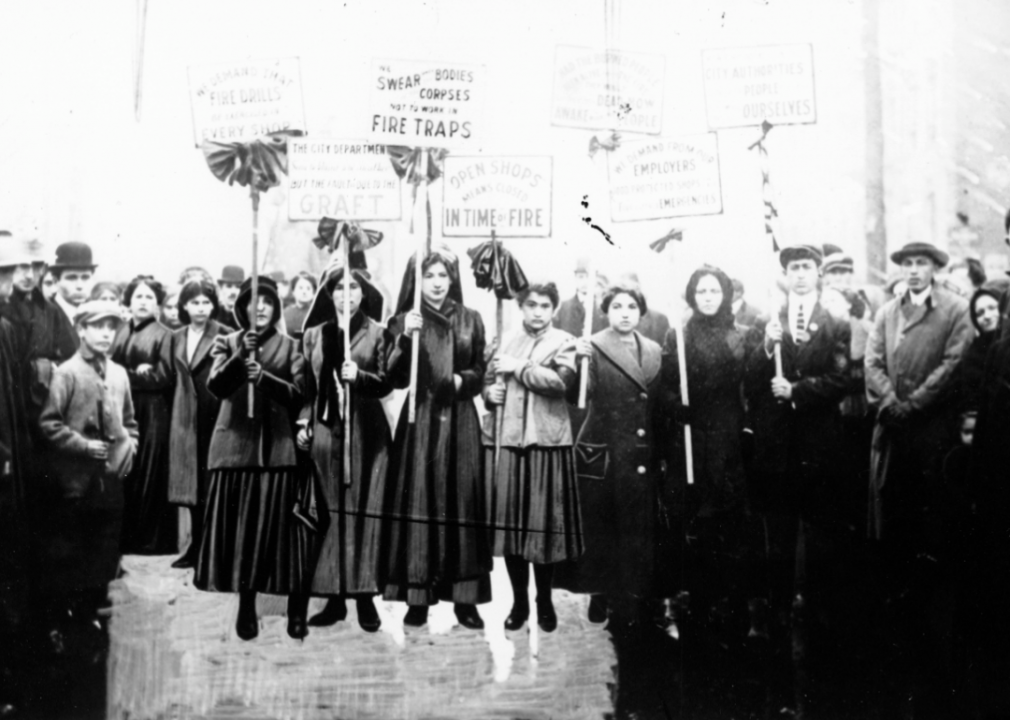
Kheel Center // Wikimedia Commons
1911: Triangle Shirtwaist fire protests
Labor rights activists mounted parades to draw attention to dangerous workplace conditions and mourn the victims of a fire at the Triangle Shirtwaist Factory that killed 146 garment workers in New York City on April 5, 1911. Legislation was passed a few years later to increase workplace safety and allow people to work fewer hours.
[Pictured: Mourners picket after the Triangle fire in 1911.]
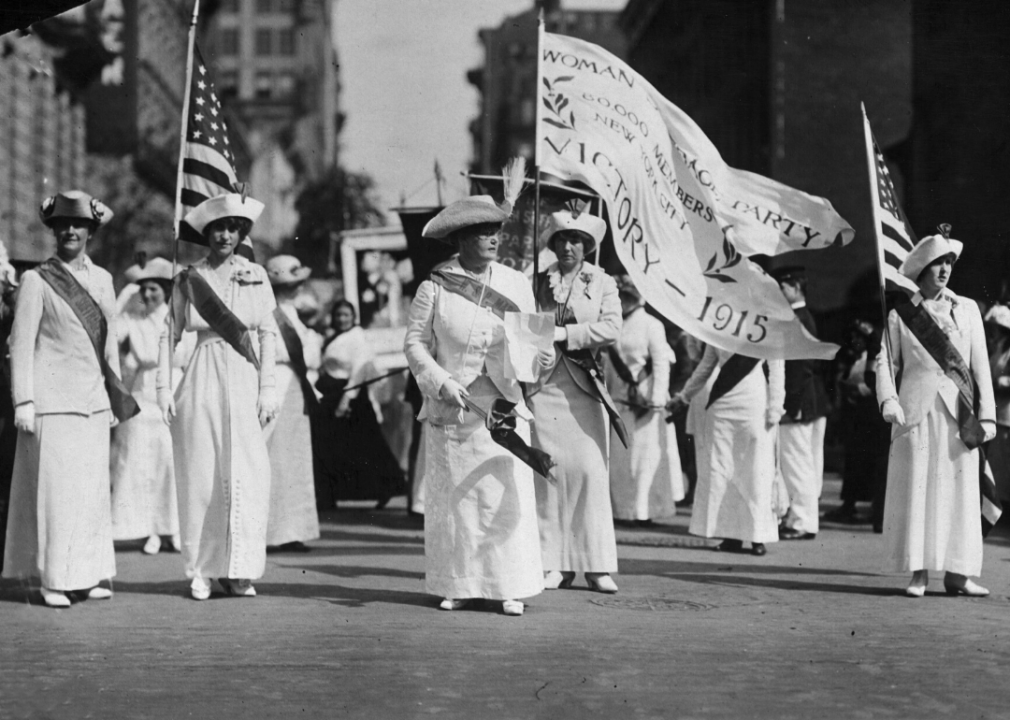
Paul Thompson/Topical Press Agency // Getty Images
1913: Suffrage movement
An estimated 5,000–8,000 protesters gathered to march down Pennsylvania Avenue in Washington D.C., ahead of President Woodrow Wilson’s inauguration in 1913 to call for women’s suffrage. People in opposition to the protest assaulted many of the demonstrators, sparking public outrage that ultimately helped increase support for women’s right to vote. It was one of many protests for the women’s suffrage movement that decade. The 19th Amendment, which granted women the right to vote, was finally passed in 1920.
[Pictured: Women lead the Manhattan Delegation on a Woman Suffrage Party parade through New York City in 1915.]
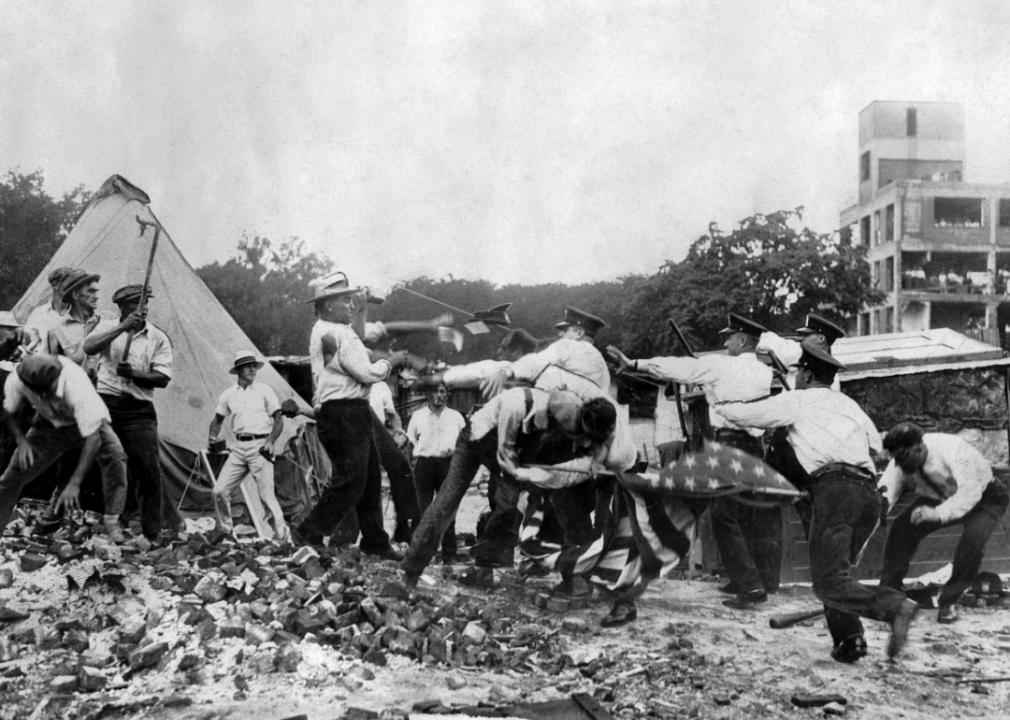
U.S. Army // Wikimedia Commons
1932: Bonus Army march
Around 20,000 veterans and their families assembled in Washington D.C., in June 1932 in anticipation of the passage of a bill that would allow former military members to cash in certificates for $1,000 bonuses early, in the midst of the Great Depression. The bill failed in the Senate, and shortly after, the U.S. Army used gas, bayonets, and other weapons to destroy the camp and chase out the protesters. The act of violence caused public outrage aimed largely at President Herbert Hoover.
[Pictured: Bonus Army marchers struggle with police.]
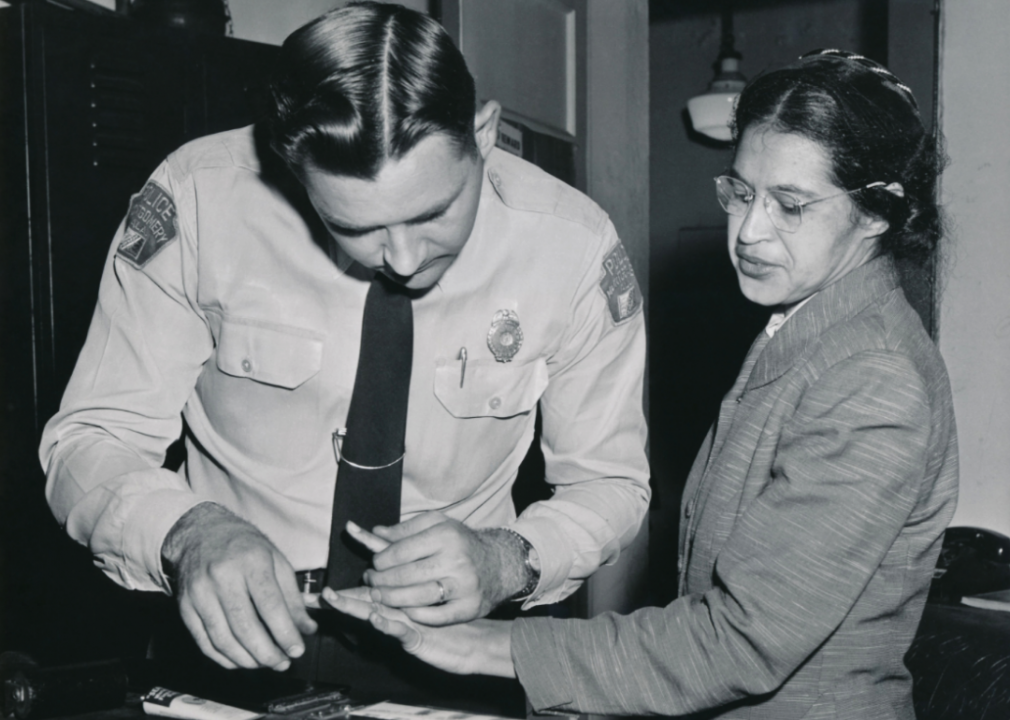
Associated Press // Wikimedia Commons
1955: The Montgomery bus boycott
After Rosa Parks was arrested for refusing to give up her bus seat to a white passenger, the Black community in Montgomery, Alabama, banded together to boycott the city bus system in December 1955. The boycott lasted more than a year, only ending once a court order forced the Montgomery buses to integrate. The protests thrust Martin Luther King Jr. into a major leadership role of the civil rights movement.
[Pictured: Rosa Parks after being arrested on Feb. 22, 1956, during the Montgomery bus boycott.]
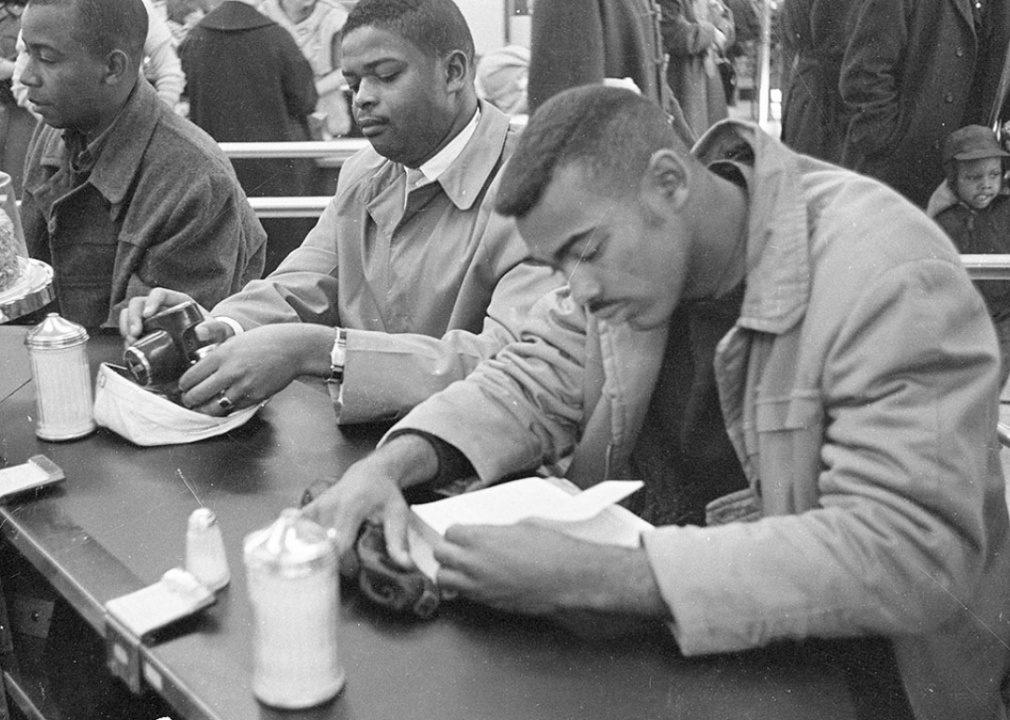
State Archives of North Carolina // Wikimedia Commons
1960: The Greensboro sit-in
On Feb. 1, 1960, a group of young African American students protested racial segregation by staging a sit-in at a Woolworth’s lunch counter in Greensboro, North Carolina. They refused to give up their seats, despite being denied service because they were Black, and even returned the following day with a larger group of protesters. The sit-ins at restaurants popped up in 55 other cities by late March and lasted through July 25 of that year. The protests led to Woolworth Department Stores ending segregation at its southern locations.
[Pictured: Civil rights protesters at a Durham, North Carolina, sit-in dated Feb. 10, 1960.]
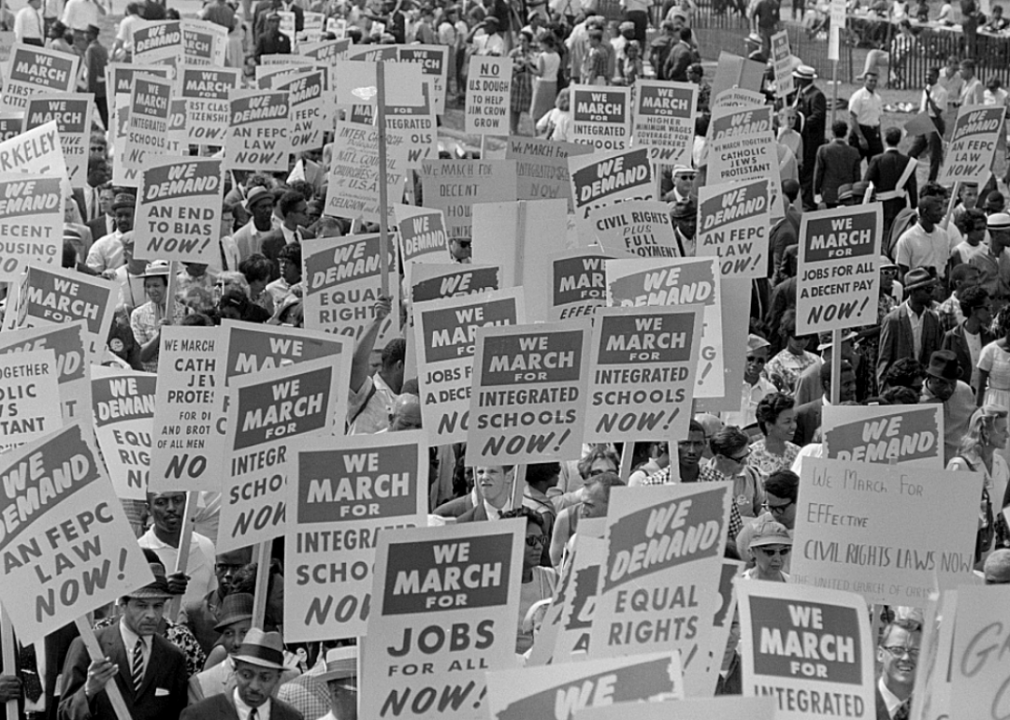
Marion S. Trikosko // Library of Congress
1963: March on Washington
More than 200,000 protesters gathered for a peaceful demonstration outside the Lincoln Memorial in Washington D.C. to call for racial equality in August 1963. There, Martin Luther King Jr. delivered his now-iconic “I Have a Dream” speech. The protest put pressure on President John F. Kennedy to push forward civil rights policies. It also helped get the Civil Rights Act of 1964 passed.
[Pictured: Looking out on a sea of signs during the March on Washington, Aug. 28, 1963.]
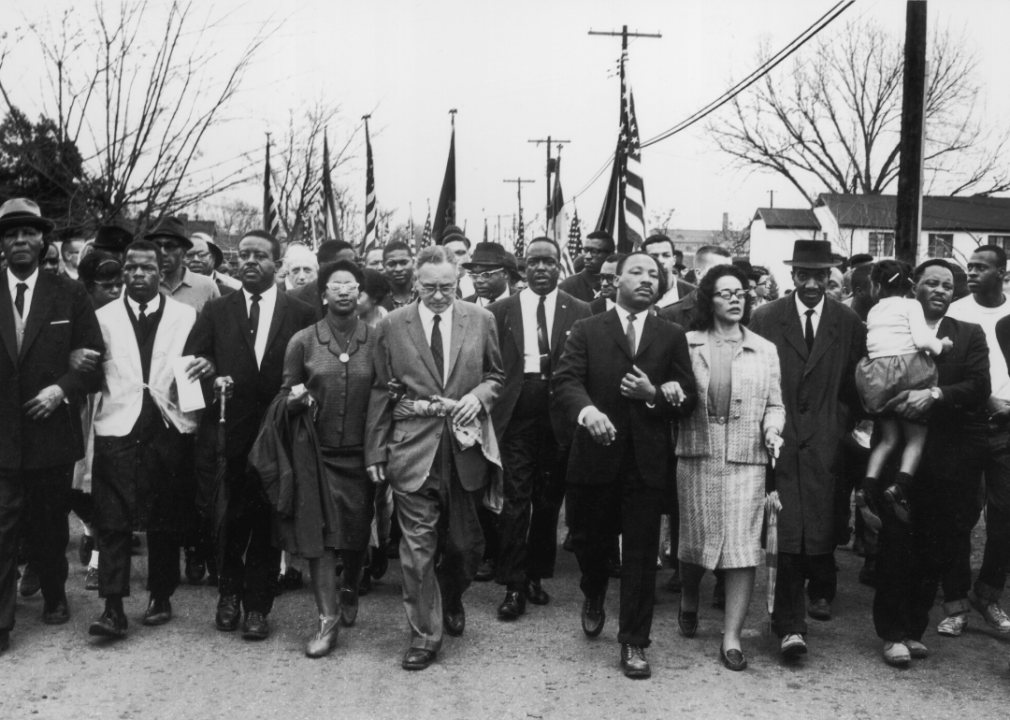
William Lovelace/Express // Getty Images
1965: Selma to Montgomery march
Thousands of peaceful activists led by Martin Luther King Jr. trekked from Selma, Alabama, to the state’s capital of Montgomery in March 1965 to call for an end to the suppression of Black voters. Protesters were met with violence from white supremacist groups and local authorities throughout the five-day, 54-mile journey. President Lyndon B. Johnson would sign the Voting Rights Act of 1965 just a few months later.
[Pictured: Martin Luther King Jr. and his wife Loretta Scott King lead the march from Selma to Montgomery, Alabama, on March 30, 1965.]
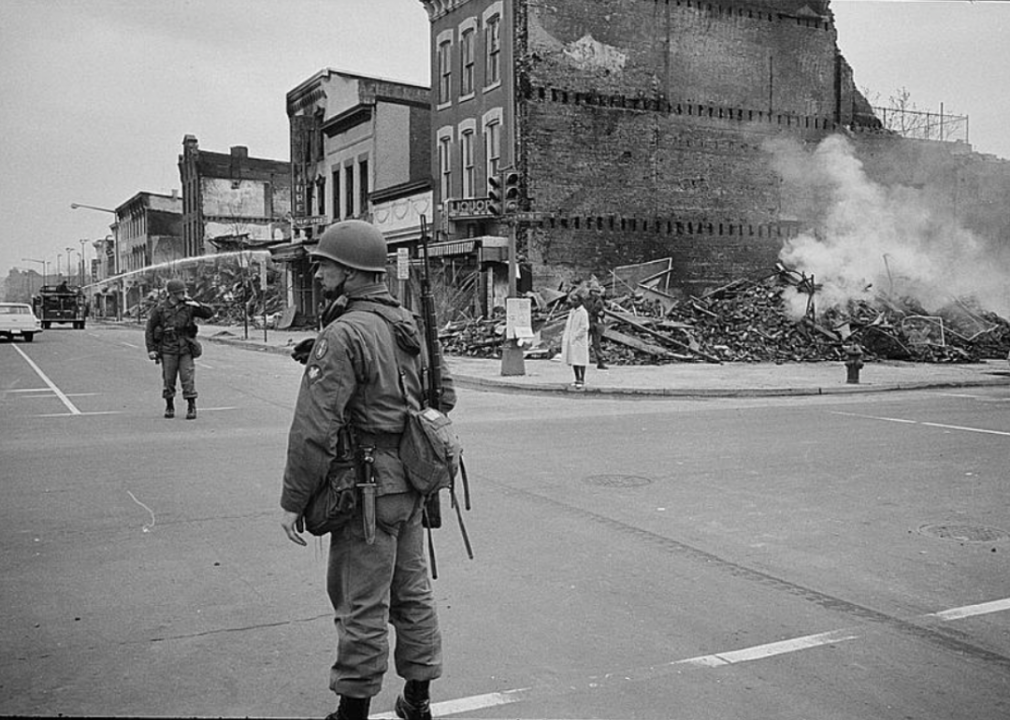
Warren K. Leffler // Library of Congress
1968: Holy Week Uprisings
A wave of civil unrest swept through the nation after Martin Luther King Jr. was assassinated on April 4, 1968, with the largest riots occurring in Washington D.C., Chicago, and Baltimore. The National Guard and federal troops were called in to stop many of the riots, which left 43 dead and thousands arrested. The riots helped revive a bill for federal fair housing and get the legislation passed in Congress.
[Pictured: A soldier stands in front of the ruins of buildings destroyed during the uprisings in Washington D.C. on April 8, 1968.]
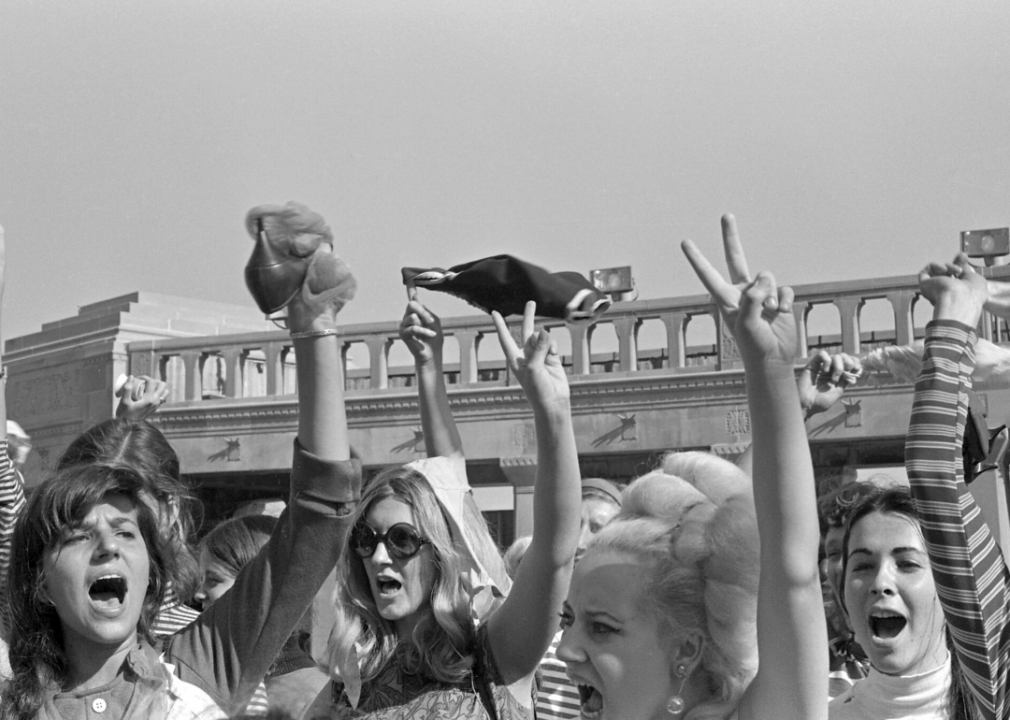
Bev Grant // Getty Images
1968: Bra ‘burning’ at Miss America pageant
Around 400 second-wave feminists organized a protest of the Miss America pageant near New Jersey’s Atlantic City Convention Center on Sept. 7, 1968. They wanted to speak out against the “ludicrous beauty standards” women were supposed to adhere to, according to Megan Gibson of Time. The protesters tossed bras and other symbols of oppression into a trash can, which was never set on fire, but still gave birth to the myth of the “bra-burning feminist.”
[Pictured: Demonstrators protest the Miss America beauty pageant in Atlantic City, New Jersey.]
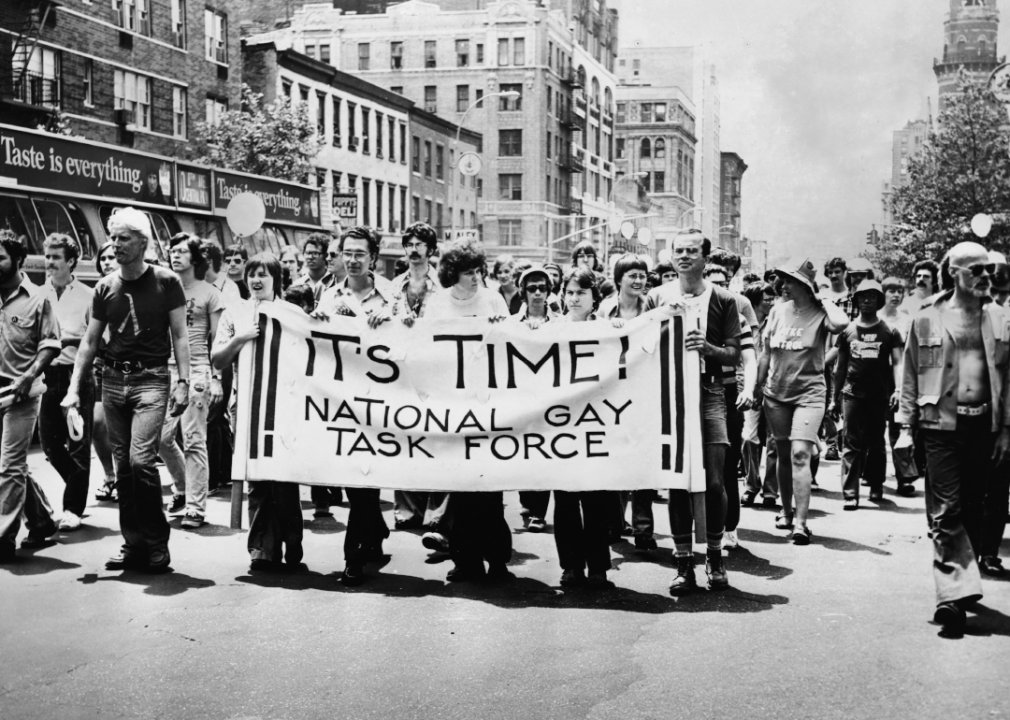
Peter Keegan/Authenticated News // Getty Images
1969: Stonewall Inn riots
On June 28, 1969, New York City police conducted a raid on a gay bar called the Stonewall Inn. Spontaneous and violent protests and riots occurred immediately after the raid and continued for the next six days. The unrest ignited the gay rights movement around the world.
[Pictured: A group marches up Sixth Avenue during the annual Gay Pride parade in New York City, June 29, 1975.]
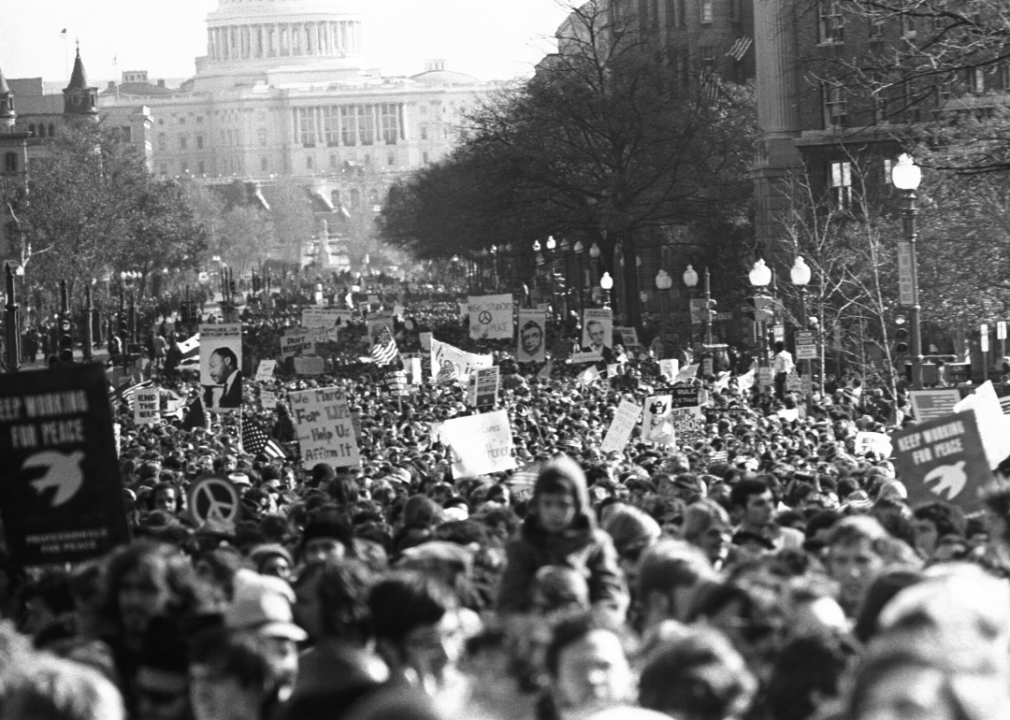
Garth Eliassen // Getty Images
1969: Vietnam War protest
The streets of Washington D.C., were flooded with more than half a million demonstrators calling for the end of the Vietnam War in November 1969. The protest was part of a string of rallies that erupted across the world that year. The war wouldn’t end for another six years.
[Pictured: View of demonstrators during the Moratorium March On Washington to protest the war in Vietnam on Nov. 15, 1969.]
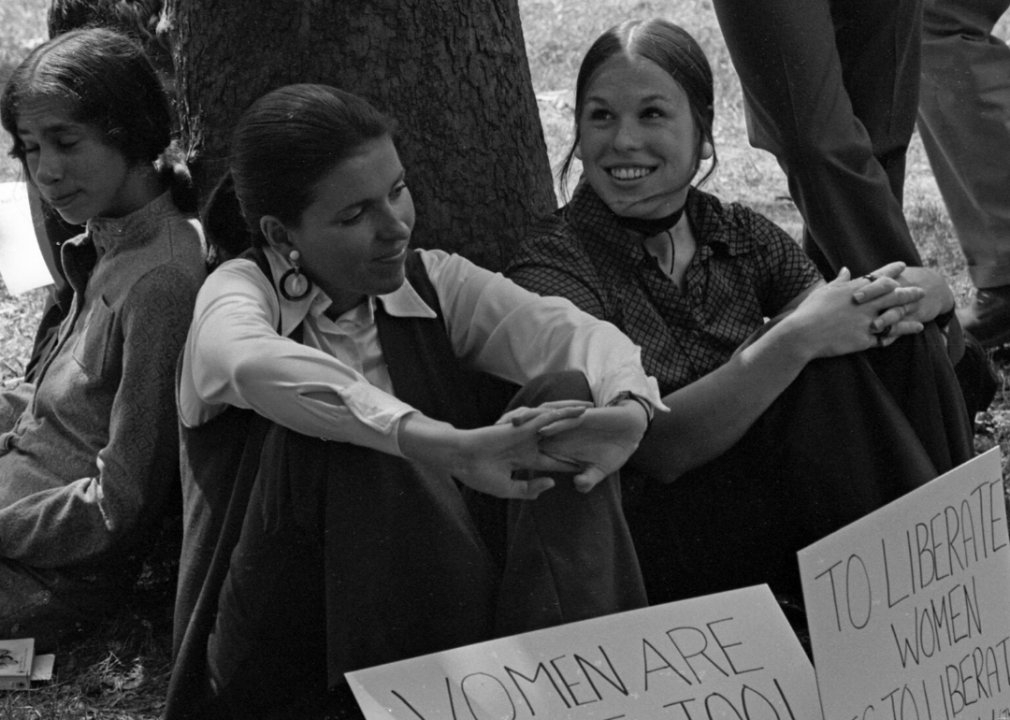
Walter Leporati // Getty Images
1970: Sit-in at Ladies’ Home Journal office
A group of around 100 feminists staged an 11-hour sit-in at the offices of Ladies’ Home Journal on March 18, 1970. The protesters called for the magazine to hire women to fill editorial staff roles, including editor-in-chief, commission women writers for columns, increase employment of women of color, and raise women’s salaries, among other demands. The protest resulted in the company agreeing to let the feminists create part of an issue of the magazine, and eventually hiring only women editors-in-chief starting in 1973.
[Pictured: Three demonstrators during the Women’s Strike for Equality in New York City on Aug. 26, 1970.]
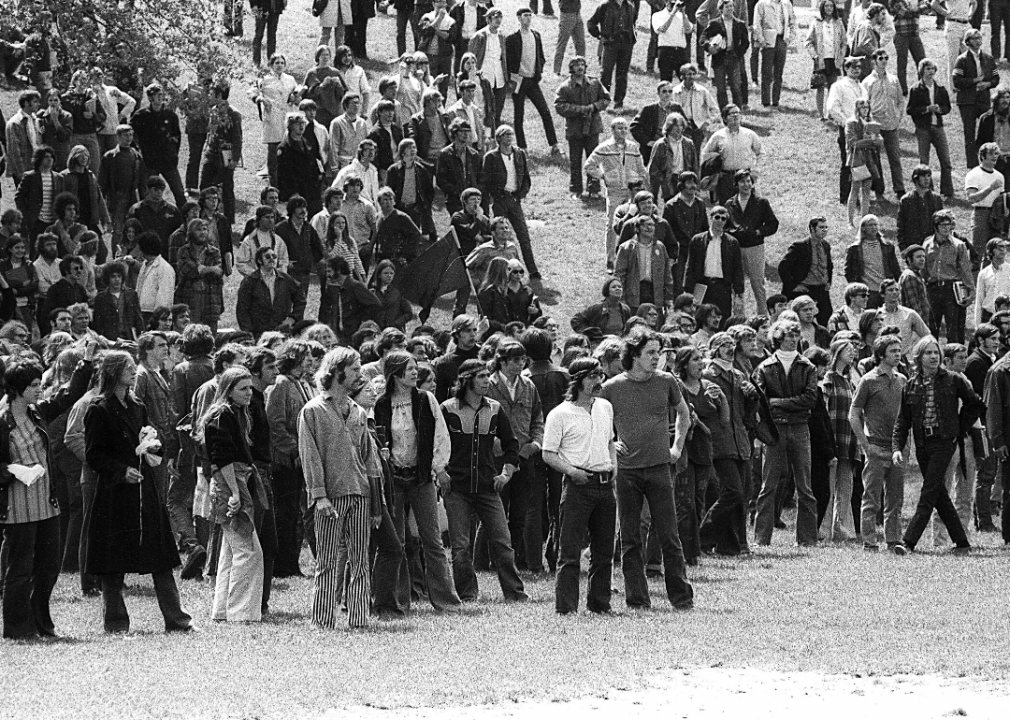
Howard Ruffner // Getty Images
1970: Kent State University anti-war gathering
Around 3,000 people gathered for an anti-war rally on the Commons of Kent State University on May 4, 1970. Ohio National Guardsman, who had been called to the campus after protesters and local police had a violent confrontation the week before, fired at the protesters, killing four and injuring another nine people. The shootings triggered student strikes nationwide and “began the slide into Watergate, eventually destroying the Nixon administration,” according to Jerry M. Lewis and Thomas R. Hensley of Kent State University.
[Pictured: View of students at an anti-war demonstration at Kent State University in Ohio on May 4, 1970.]
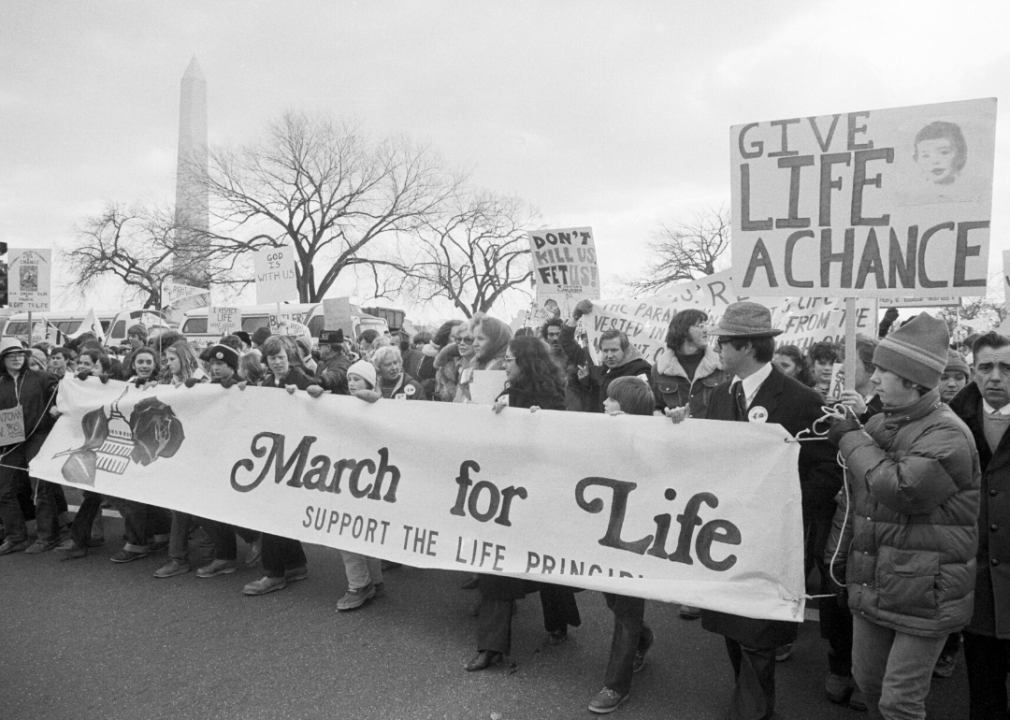
Bettmann // Getty Images
1973: March for Life
Anti-abortion protesters gathered in Washington D.C., for the first March for Life rally on Jan. 22, 1974. While it was initially intended as a one-time event aimed at pressuring the Supreme Court to overturn Roe v. Wade, the March for Life became an annual event continuing today. In 2020, President Donald Trump spoke at the March for Life, making him the first president to do so.
[Pictured: Anti-abortion demonstrators pass the Washington Monument on their way to the U.S. Capitol on Jan. 22, 1979.]
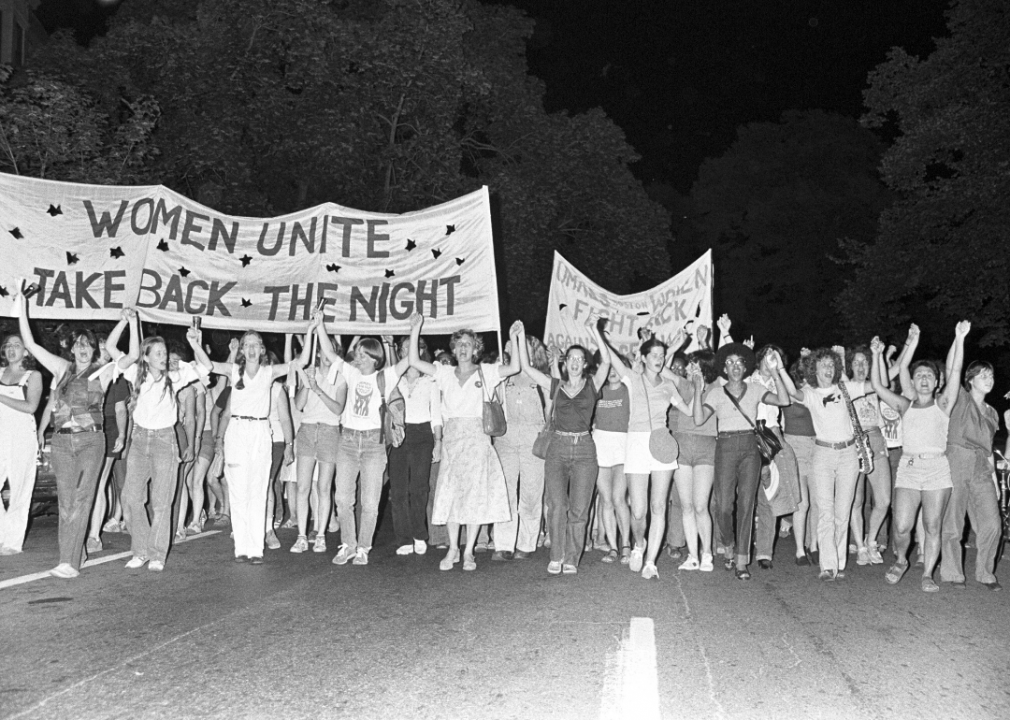
Spencer Grant // Getty Images
1973: First Take Back The Night march in the US
Take Back The Night events began in Belgium and England in the 1960s to draw awareness to the issue of women feeling unsafe walking on streets alone at night. The movement hit the United States in 1973 at the University of Southern Florida, when women dressed in black sheets and paraded through the campus while holding broomsticks, demanding that the school open a women’s center. Take Back The Night protests now occur annually in communities around the world as part of an effort to end sexual violence.
[Pictured: Participants hold a banner for Take Back The Night in Boston 1978.]

Warren K. Leffler // Library of Congress
1976: Marches for the Equal Rights Amendment
The National Organization for Women staged a series of marches and protests in Illinois beginning in May 1976 protesting the state’s resistance to ratification of the Equal Rights Amendment (ERA). The first demonstration drew about 16,000 people to Springfield, Illinois, while a record 90,000 people attended another march in Chicago on Mother’s Day 1980. Illinois eventually ratified the ERA in 2018.
[Pictured: Women’s Equal Rights parade in Washington D.C. on Aug. 26, 1977.]

Mark Reinstein // Corbis via Getty Images
1979: National March on Washington for Lesbian and Gay Rights
After attempting to organize a march for LGBT rights since 1973, activists finally made it happen with the National March on Washington for Lesbian and Gay Rights on Oct. 14, 1979. The event attracted up to 125,000 members and allies of the LGBT community and urged Congress to pass protective civil rights legislation. It helped make the gay rights movement a national issue.
[Pictured: Attendees gather around the Washington Monument at the first National March on Washington for Lesbian and Gay Rights.]
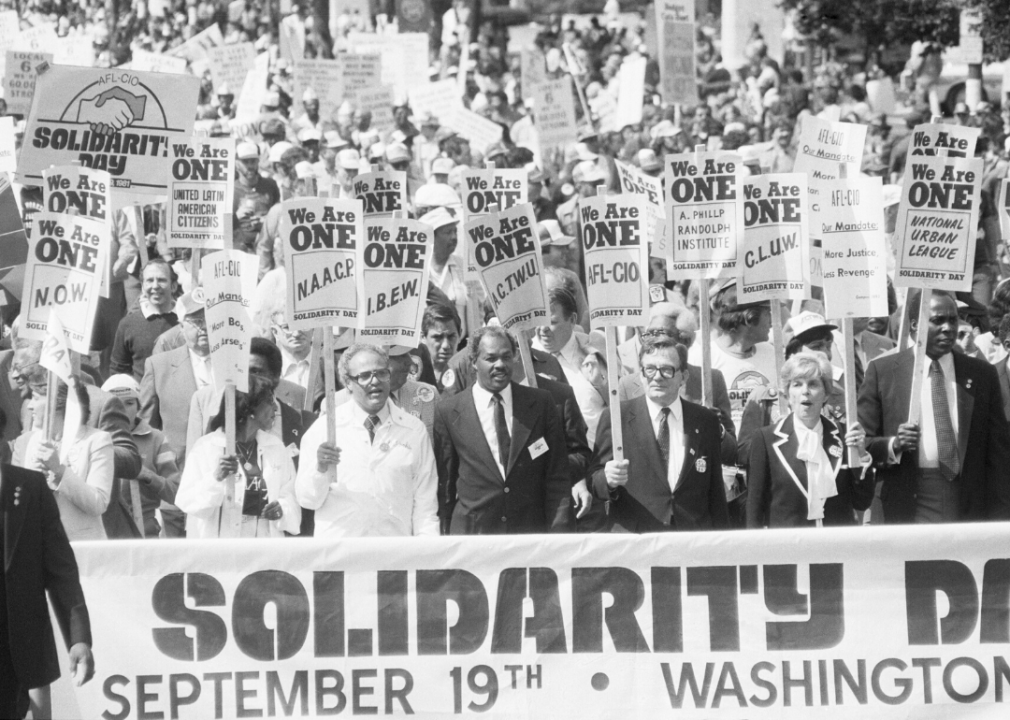
Bettmann // Getty Images
1981: Solidarity Day march
Around 260,000 people took to the streets of Washington D.C., on Sept. 19, 1981, for the Solidarity Day march against union-busting. The protest was sparked after President Ronald Reagan fired more than 12,000 air traffic controllers who had been striking for increased workplace safety and higher wages.
[Pictured: Marchers, including Washington Mayor Marion Barry, Lane Kirkland, president of AFL-CIO, Vernon Jordan, and Coretta Scott King, head down Constitution Avenue in Washington D.C. on Sept. 19, 1981.]
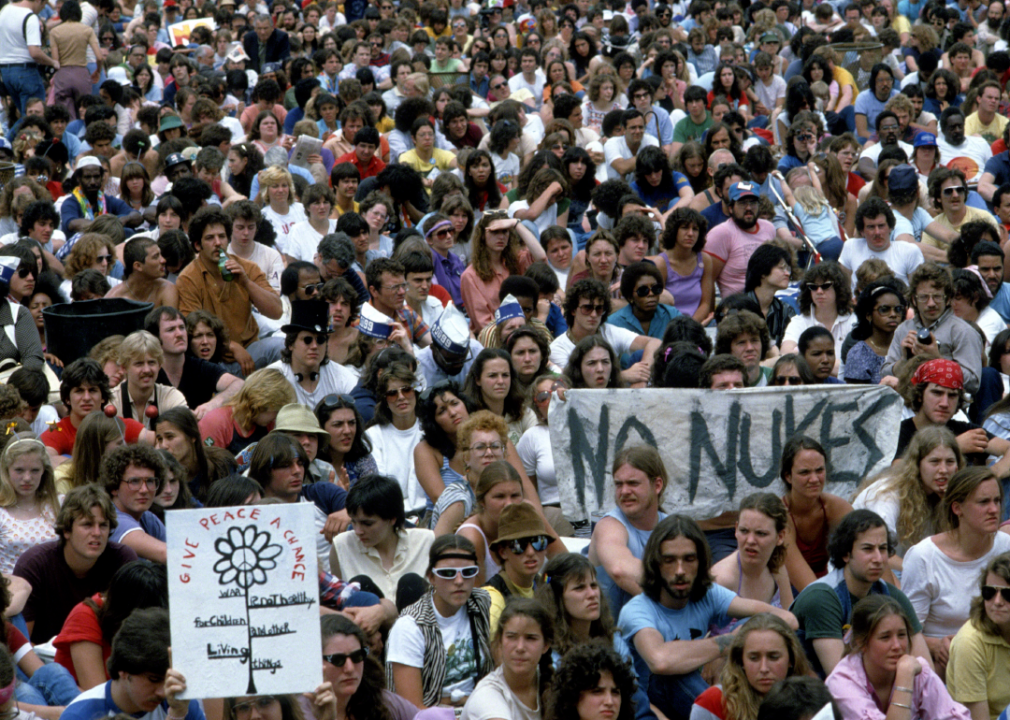
PL Gould/IMAGES // Getty Images
1982: Anti-nuclear protest in Central Park
An estimated 1 million protesters gathered in New York City’s Central Park on June 12, 1982, to protest nuclear weapons. The event was intended to show widespread support for nuclear disarmament ahead of the United Nations Second Special Session on Disarmament.
[Pictured: A crowd participates in a peace rally in Manhattan’s Central Park in 1982.]
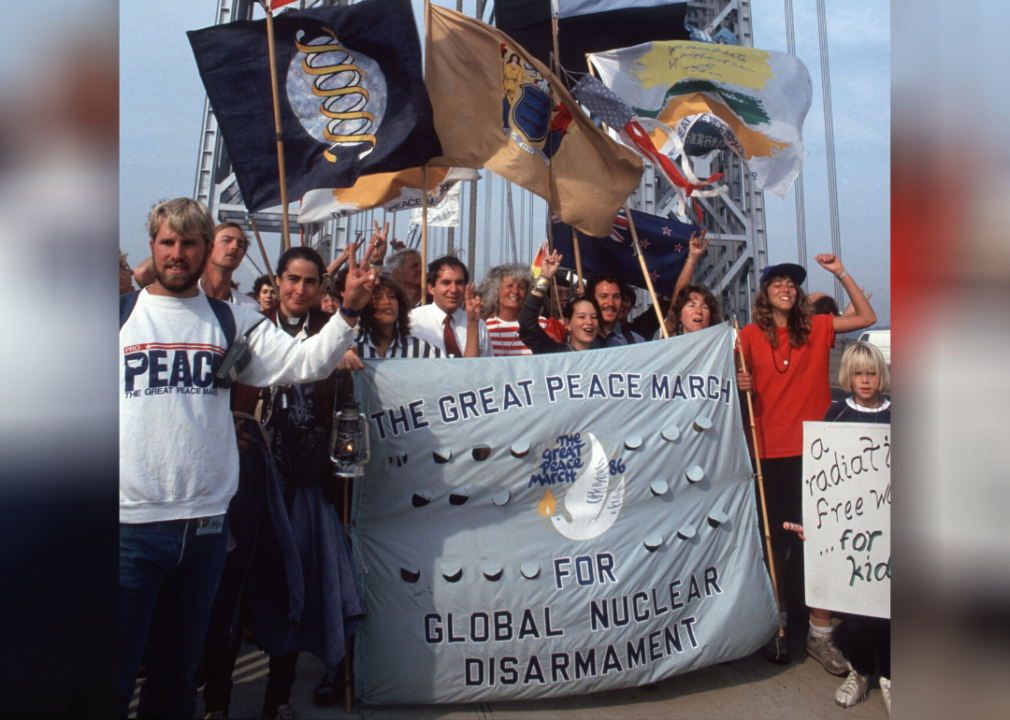
Allan Tannenbaum // Getty Images
1986: Great Peace March for Global Nuclear Disarmament
The Great Peace March for Global Nuclear Disarmament was a cross-country walk organized to raise awareness for the growing threat of nuclear proliferation. Around 400 people completed the 3,600-mile, eight-month journey from Los Angeles to Washington D.C. It ended with the marchers and thousands of supporters singing “This Land Is Your Land” in unison across from the White House.
[Pictured: The Great Peace March protesters travel across the George Washington Bridge in New York City on Oct. 23, 1986.]
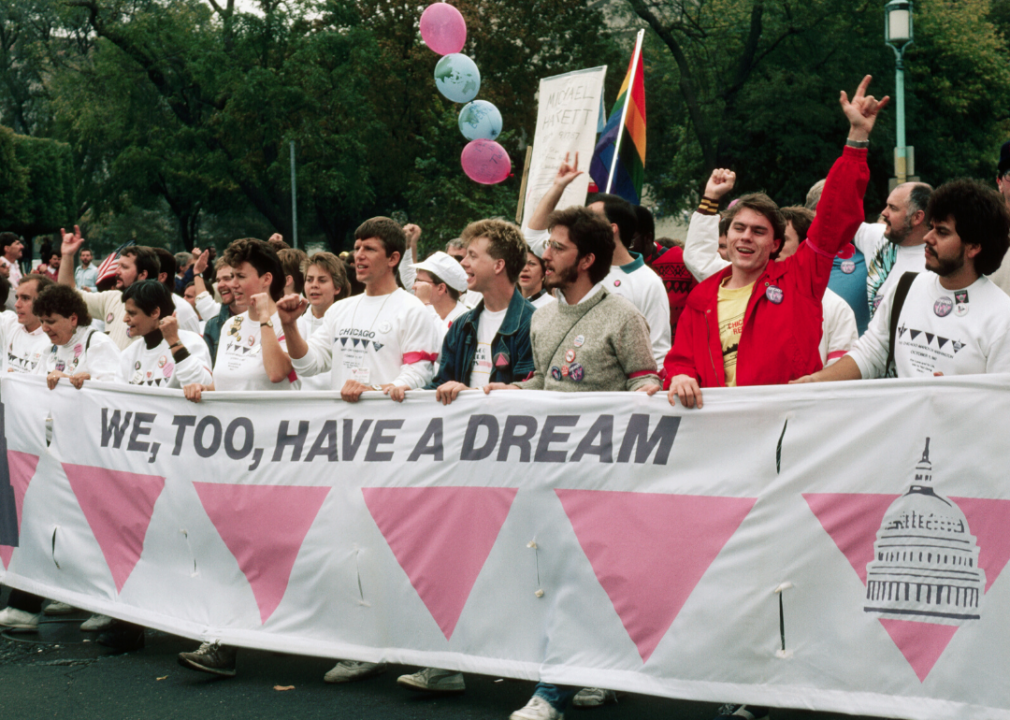
LEE SNIDER/PHOTO IMAGES/Corbis via Getty Images
1987: Second National March on Washington for Lesbian and Gay Rights
The AIDS Coalition to Unleash Power, a grassroots organization aimed at ending the AIDS epidemic, got its first national coverage on Oct. 11, 1987, when hundreds of thousands of protesters rallied in Washington D.C. for the Second National March on Washington for Lesbian and Gay Rights. The march was just one of many activities held over a series of six days, which also included the first public viewing of the NAMES Project AIDS Memorial Quilt. It is sometimes referred to as “The Great March” for its historical significance in the gay rights movement.
[Pictured: Marchers participate in the Gay Rights March on Washington D.C. on Oct. 1, 1987.]
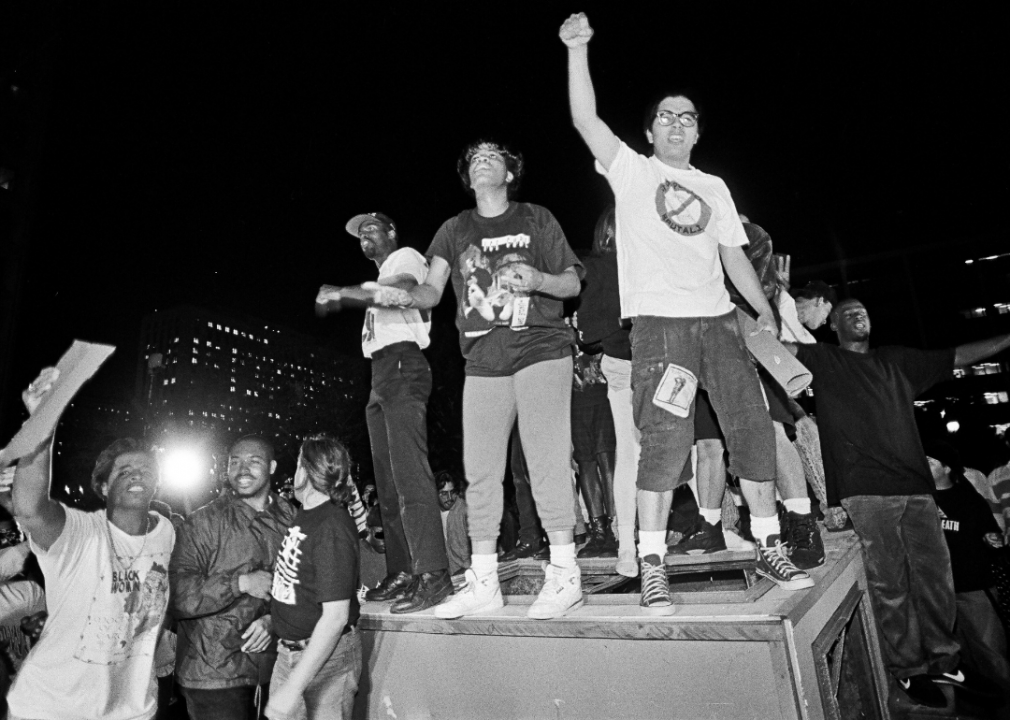
Ted Soqui/Corbis via Getty Images
1992: Los Angeles uprising
The six days of violent demonstrations of the Los Angeles uprising, also called the Los Angeles riots, occurred from April 29 to May 4, 1992, after four Los Angeles police officers—three of whom were white—were acquitted of the charges related to their brutal beating of Rodney King, a Black man. The National Guard and the U.S. military were called in to help end the unrest throughout Los Angeles.
[Pictured: A crowd amidst the uprising in West Hollywood, Los Angeles, on April 30, 1992.]
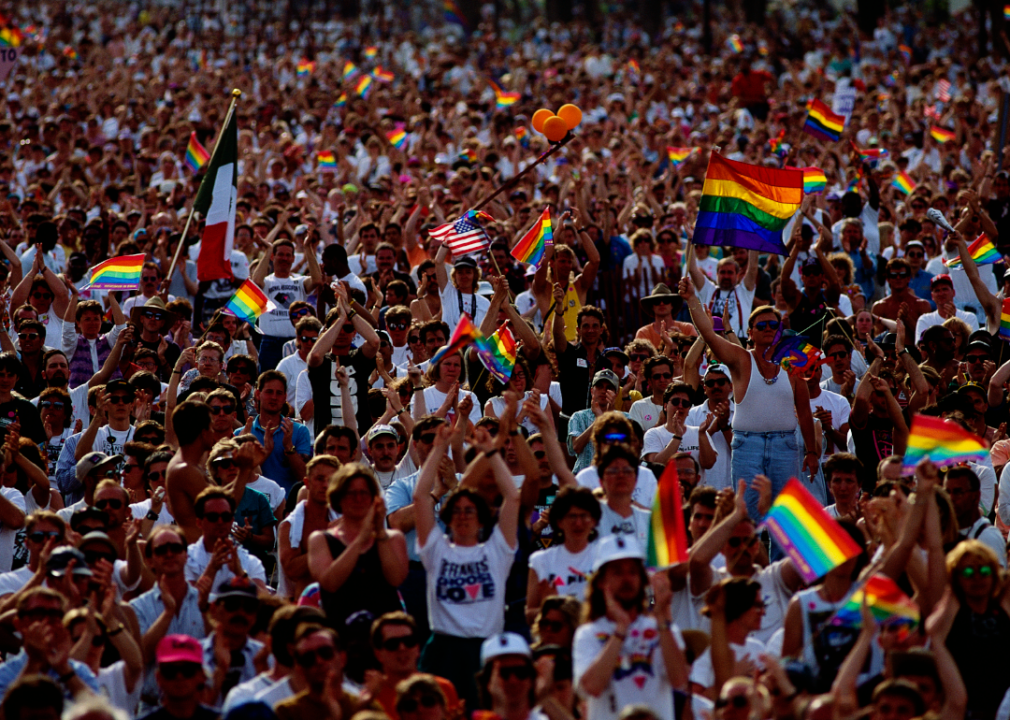
Shepard Sherbell/CORBIS SABA/Corbis via Getty Images
1993: March on Washington for Lesbian, Gay, and Bi Equal Rights and Liberation
An estimated 1 million people participated in the March on Washington for Lesbian, Gay, and Bi Equal Rights and Liberation at the D.C. Mall on April 25, 1993. The protesters had seven primary demands, including a civil rights bill to end discrimination against members of the LGBT community and increased funding for AIDS research and treatments, among others. The event helped give people of all sexual orientation greater attention from the media and politicians.
[Pictured: A large crowd cheers at the March on Washington for Lesbian, Gay, and Bisexual Rights on March 25, 1993.]
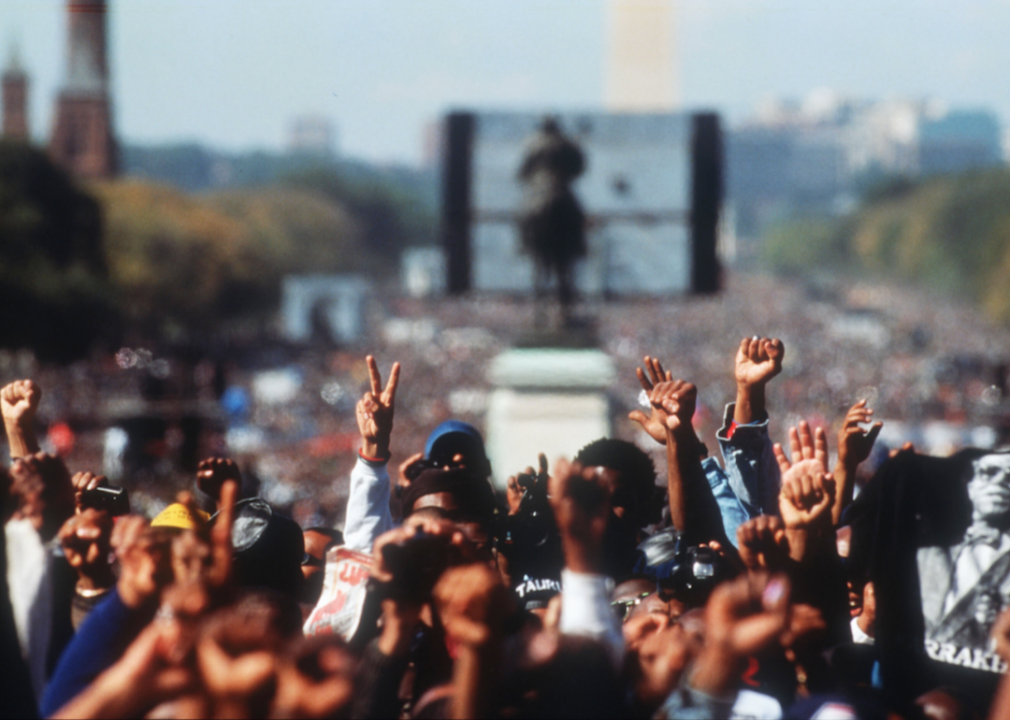
Porter Gifford/Liaison // Getty Images
1995: Million Man March
In an effort to encourage African American unity and promote family values, between 400,000 and 1.1. million people—most of whom were Black men—gathered in Washington D.C. for the Million Man March on Oct. 16, 1995. The event featured speeches from Rosa Parks, Maya Angelou, Cornel West, Jesse Jackson, and other prominent attendees. A theme throughout the march and events was for Black people to register to vote as a means to gain more political say-so. Following the events, around 1.7 million African American men became registered voters.
[Pictured: Attendees at the Million Man March raise their hands in fists and peace/victory signs Oct. 16, 1995, in Washington DC.]
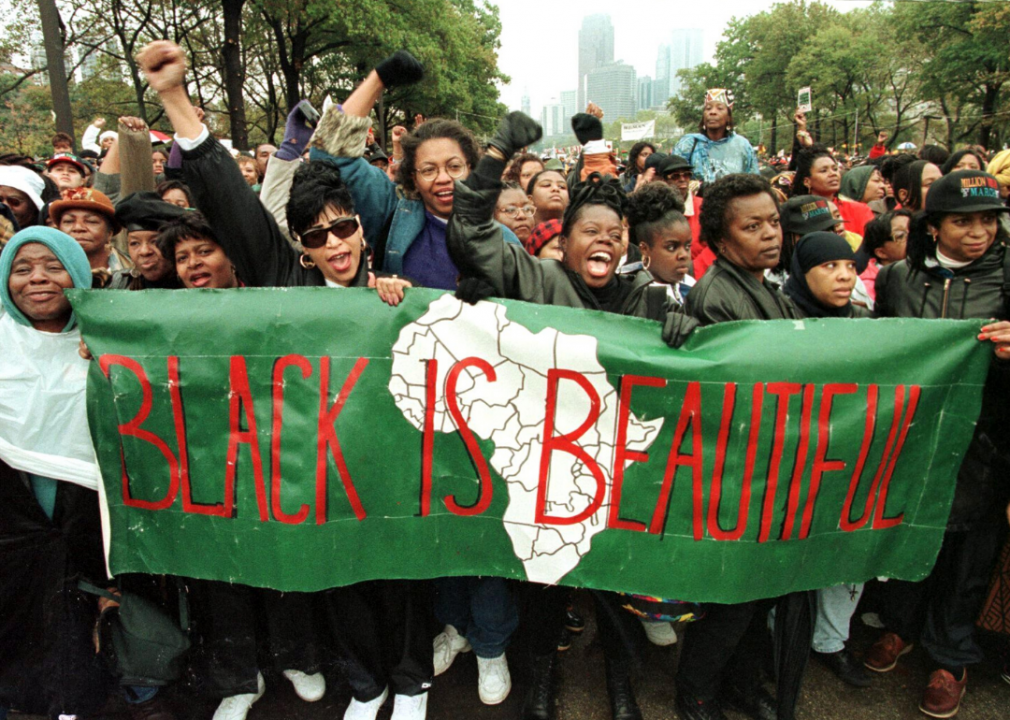
TOM MIHALEK/AFP via Getty Images
1997: Million Woman March
Modeled after the Million Man March two years earlier, the Million Woman March involved half a million protesters, largely comprised of Black women, parading on the Benjamin Franklin Parkway in Philadelphia on Oct. 25, 1997. The daylong event was intended to unite African American women and focus attention on issues that affected their families and communities.
[Pictured: Women cheer during a speaker’s comments at the Million Woman March on the Benjamin Franklin Parkway on Oct. 25, 1997, in Philadelphia.]
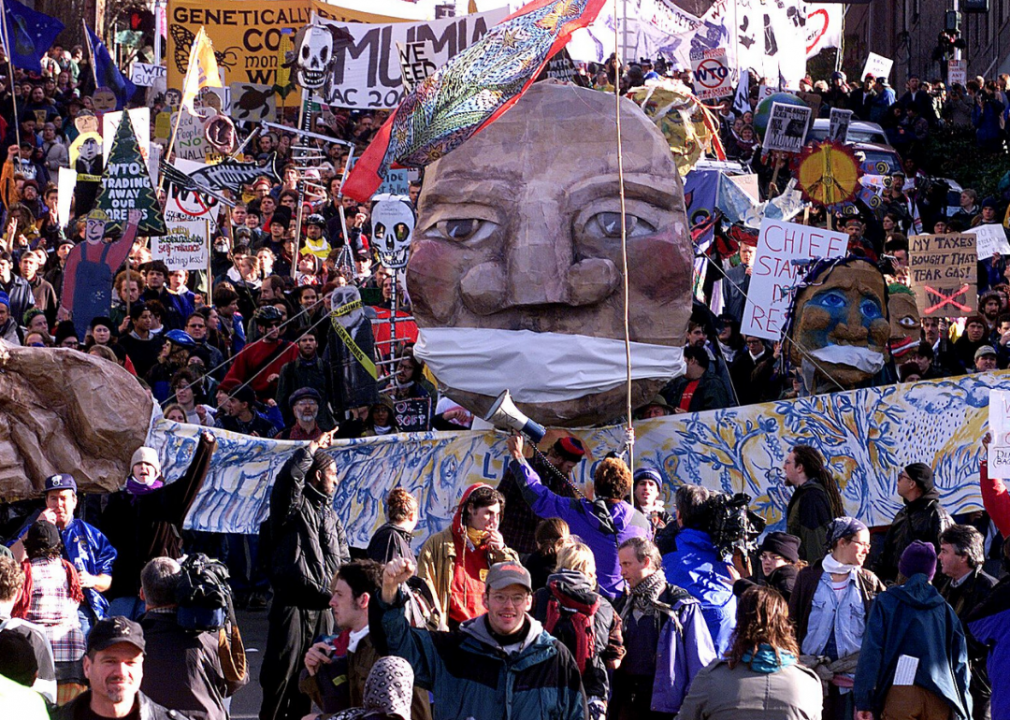
HECTOR MATA/AFP via Getty Images
1999: Seattle World Trade Organization protests
At least 40,000 protestors rallied against globalization and widening wealth inequality on Nov. 30, 1999, outside the Washington State Convention & Trade Center, which was hosting a World Trade Organization meeting. During the protest, demonstrators smashed Starbucks and Nike store windows around Seattle and police arrested around 600 people. The demonstrations proved disruptive to the WTO delegates’ meeting.
[Pictured: Demonstrators in the streets of Seattle protest the World Trade Organization summit on Dec. 2, 1999.]
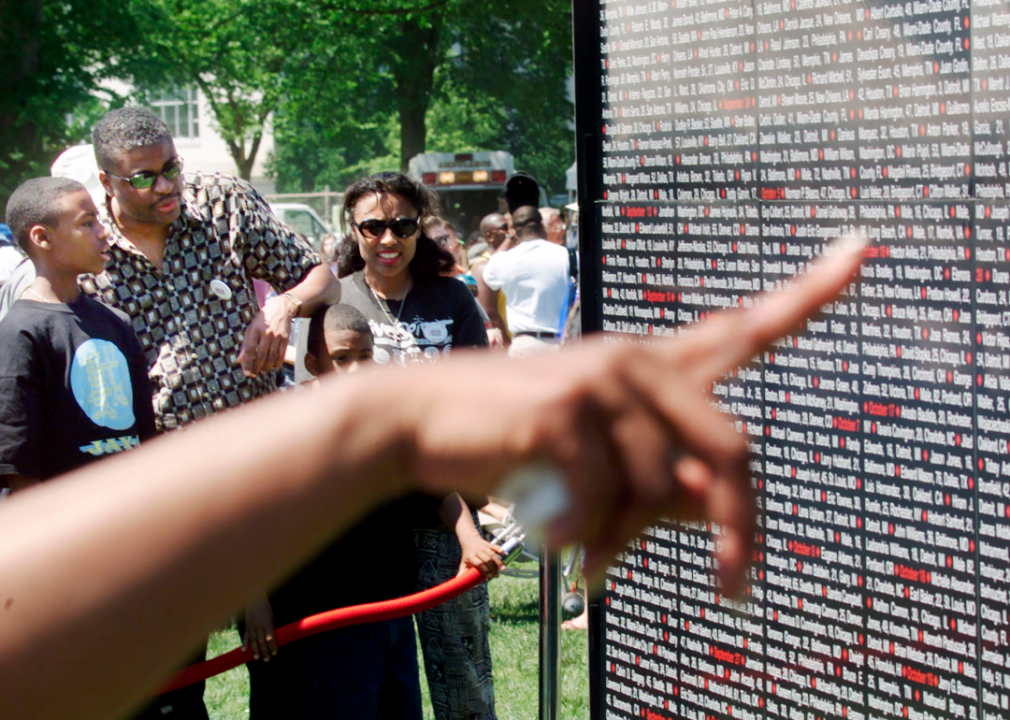
Mark Wilson/Newsmakers // Getty Images
2000: The Million Mom March
Organized exclusively by word-of-mouth, the Million Mom March drew around 750,000 people to Washington’s National Mall on Mother’s Day 2000 to call for increased gun control regulations. The protest included a display of a “wall of death” that contained the names of more than 4,000 victims of gun violence.
[Pictured: Million Mom March protesters look and point to a wall with the names of people killed by guns May 14, 2000, in Washington D.C.]
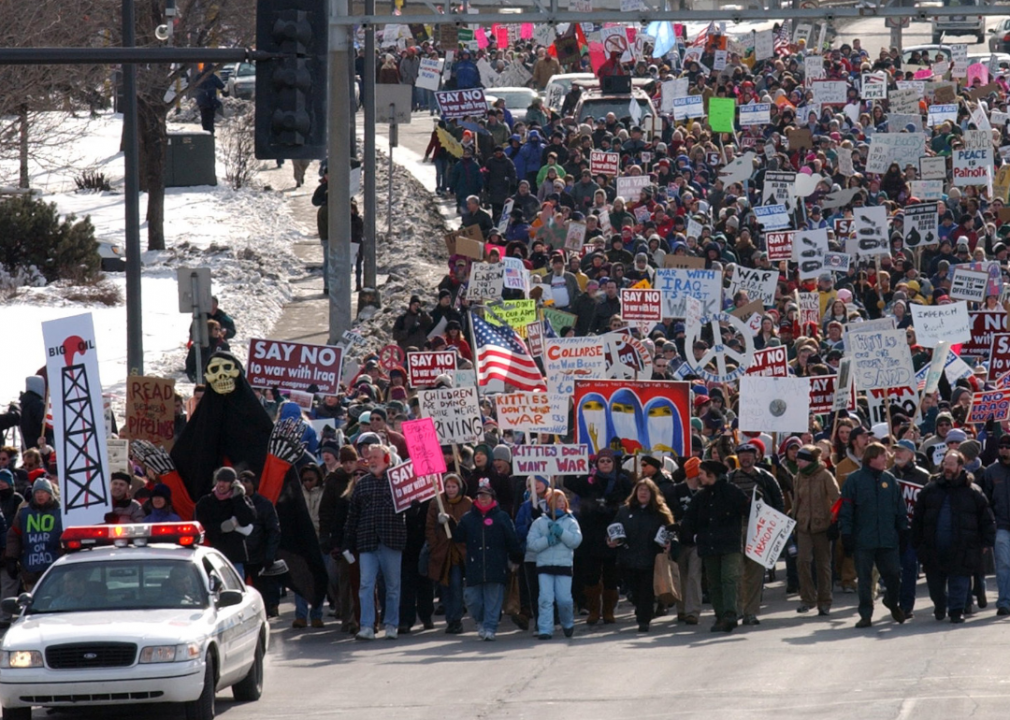
JOEY MCLEISTER // Star Tribune via Getty Images
2003: Iraq War protests
Hundreds of thousands of demonstrators gathered near the United Nations in New York City on Feb. 15, 2003, to rally against the war with Iraq. Similar protests (as well as counter-protests) took place in major U.S. cities and around the world. The protests failed to prevent the war, but did demonstrate widespread disapproval of the Bush administration’s plan, helped avoid a war in Iran “and inspired a generation of activists,” according to Phyllis Bennis, author of “Challenging Empire: How People, Governments and the U.N. Defy U.S. Power.”
[Pictured: Anti-war marchers in Minneapolis on Feb. 15, 2003.]
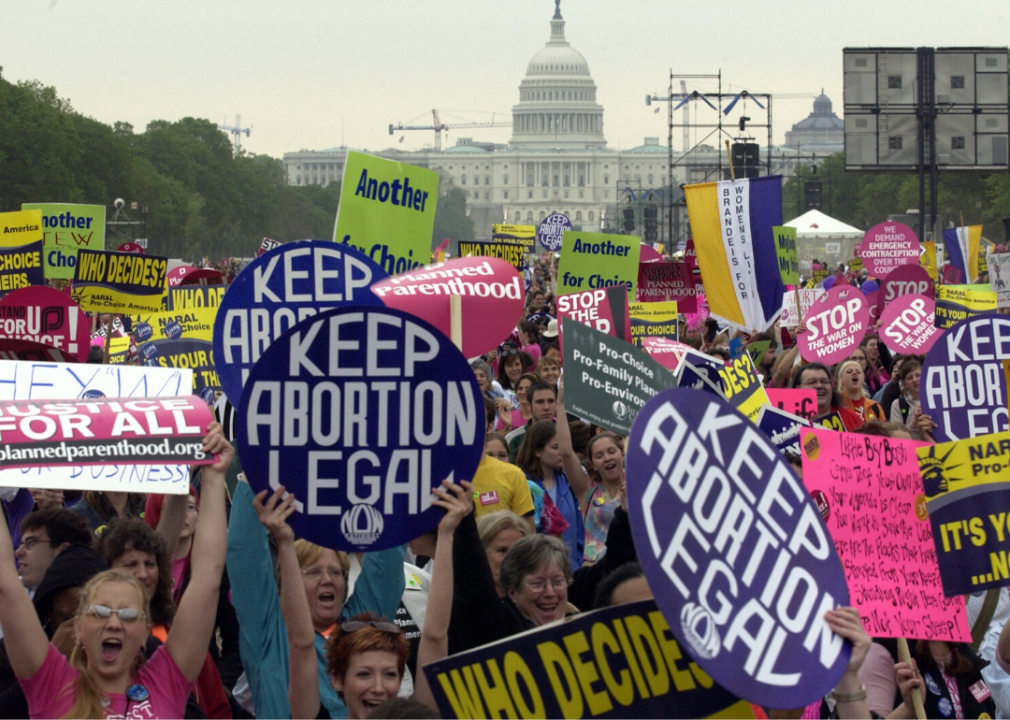
Stephen J. Boitano // LightRocket via Getty Images
2004: March for Women’s Lives
Around 1.15 million demonstrators took to the streets of Washington D.C. on April 25, 2004, for the March for Women’s Lives, a rally to call for protection of abortion rights and access to birth control and reproductive health care, according to the National Organization for Women. The event made major news headlines and inspired the creation of a new voter registration campaign known as “10 for Change.”
[Pictured: Pro-choice supporters take part in the March For Women’s Lives in Washington D.C. on April 25, 2004.]
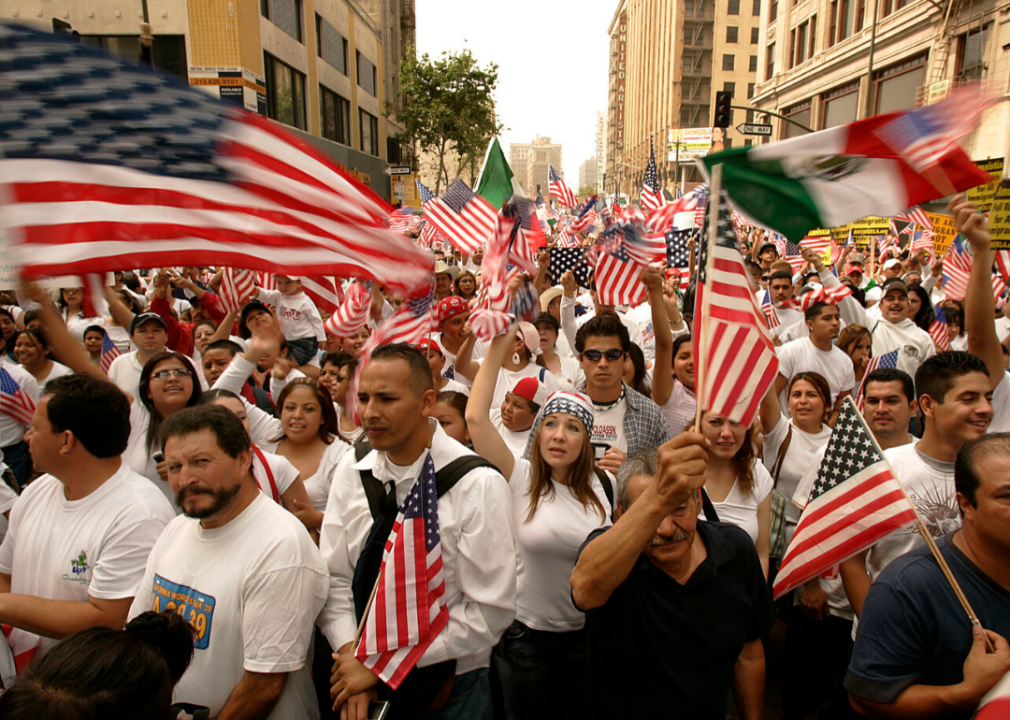
Brian Vander Brug // Los Angeles Times via Getty Images
2006: The Day Without an Immigrant
The Day Without an Immigrant, also known as the Great American Boycott, involved immigrants across the United States boycotting schools and businesses on May 1, 2006, in an effort to demonstrate the necessity of undocumented immigrant labor to the economy. The event also included rallies and marches across the country, spearheaded by two marches in Los Angeles that drew up to 2 million people. On the day of the event, Cargill Meat Solutions shut down seven of its plants, giving 15,000 workers the day off, and Goya Foods suspended delivery in most of the United States.
[Pictured: Immigrants and their supporters gather in downtown Los Angeles on May 1, 2006.]
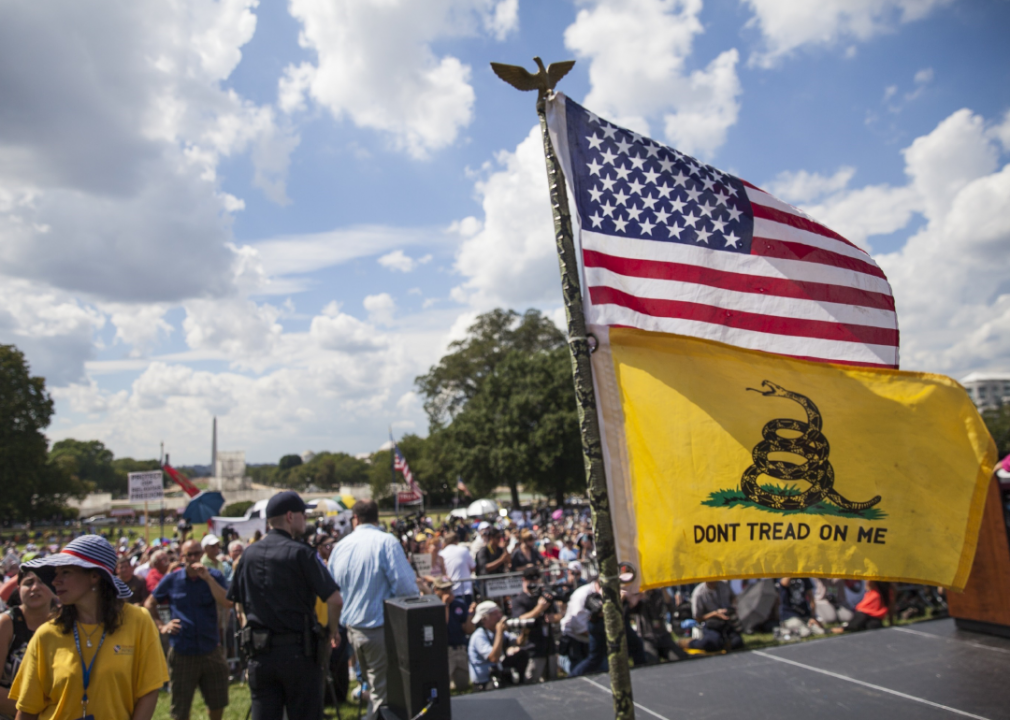
Samuel Corum/Anadolu Agency // Getty Images
2009: Tea Party protests
A series of protests related to the Tea Party movement, a conservative political movement aimed at fighting excessive taxes and government regulation on the private sector and increasing immigration controls, occurred throughout the United States in 2009. While a lack of leadership gave the grassroots movement limited power, Tea Partiers did make an impact on elections in 2009 and 2010, putting momentum behind conservative and libertarian candidates.
[Pictured: Flags fly on the side of the stage at a rally held by the Tea Party at a rally in Washington D.C. on Sept. 9, 2015.]
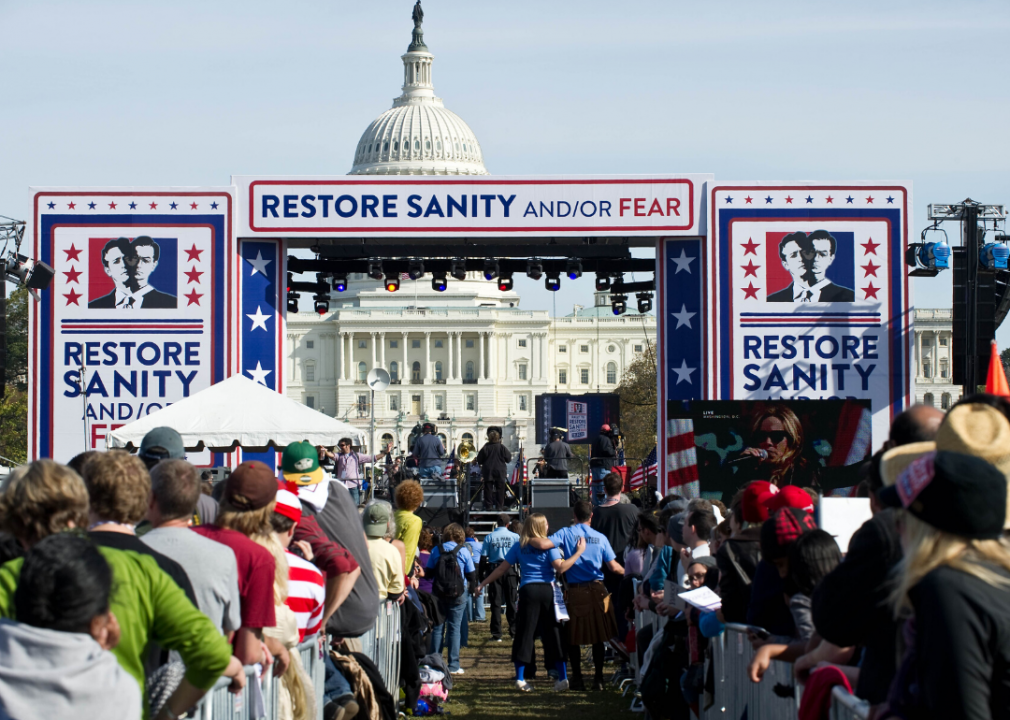
NICHOLAS KAMM/AFP via Getty Images
2010: Rally to Restore Sanity and/or Fear
Satirical news show hosts Jon Stewart and Stephen Colbert drew more than 200,000 people to the National Mall in Washington D.C. on Oct. 30, 2010, for the Rally to Restore Sanity and/or Fear. The rally, which mocked the Reclaim the Dream and Restoring Honor rallies, was intended to draw attention away from partisan politics and instead focus the political conversation against corruption. Donations from the rally’s charity drive brought in hundreds of thousands of dollars in contributions to DonorsChoose.org and the Trust for the National Mall.
[Pictured: People gather on the National Mall in Washington D.C. on Oct. 30, 2010, for the Rally Restore Sanity and/or Fear.]
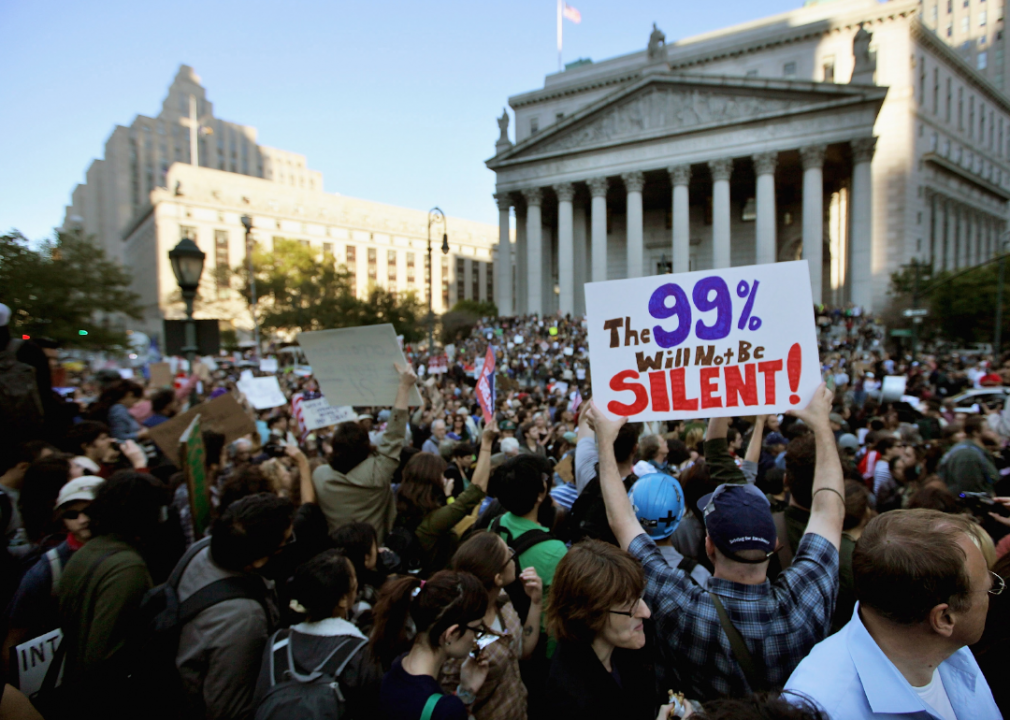
Mario Tama // Getty Images
2011: Occupy Wall Street
After being denied entrance to Wall Street, thousands of activists set up a demonstration with hundreds camping out overnight, at nearby Zuccotti Park in New York City to protest against economic inequality in September 2011. The protest lasted for months and inspired other Occupy demonstrations in cities around the world. The demonstration drew lots of attention from politicians, got around 600,000 people to transfer their savings from major banks to community credit unions, and pushed the issues of the 99% into the national spotlight.
[Pictured: Protesters affiliated with the Occupy Wall Street movement rally in Foley Square before marching though Lower Manhattan on Oct. 5, 2011.]
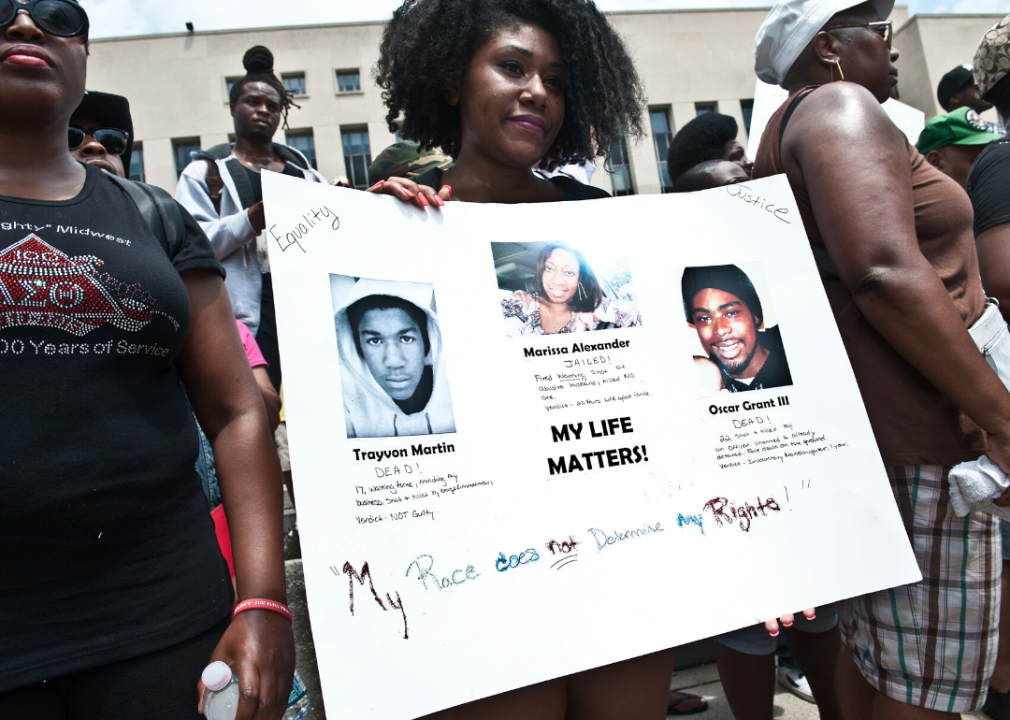
NICHOLAS KAMM/AFP via Getty Images
2013: First Black Lives Matter protests
Protests broke out across the United States after George Zimmerman was found not guilty of second degree murder for the shooting of Trayvon Martin, a Black teenager, in Sanford, Florida. The protests were part of the birth of the Black Lives Matter movement.
[Pictured: People demonstrate in Washington on July 20, 2013, following acquittal of George Zimmerman in the shooting death of unarmed Black teenager Trayvon Martin.]
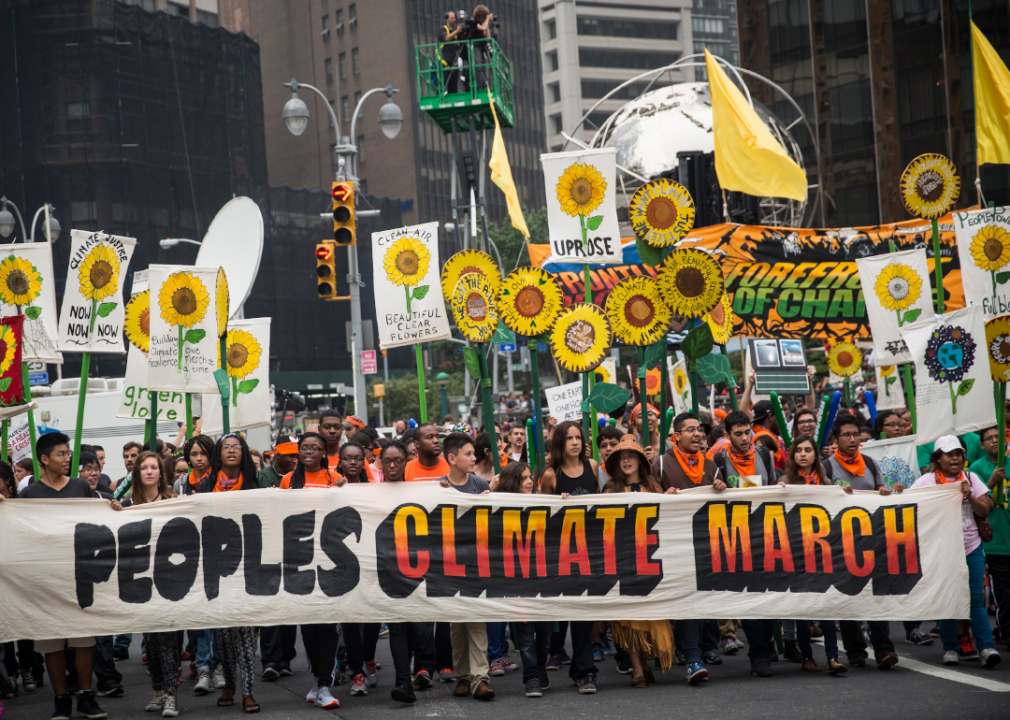
Andrew Burton // Getty Images
2014: People’s Climate March
Dubbed the largest climate change march in history, the People’s Climate March included some 310,000 demonstrators marching down the streets of Manhattan on Sept. 21, 2014. Companion events also took place around the world under the People’s Climate March banner. It drew international attention to concerns about climate change days ahead of the United Nations’ 2014 Climate Summit at its New York headquarters.
[Pictured: People protest for greater action against climate change during the People’s Climate March on Sept. 21, 2014, in New York City.]
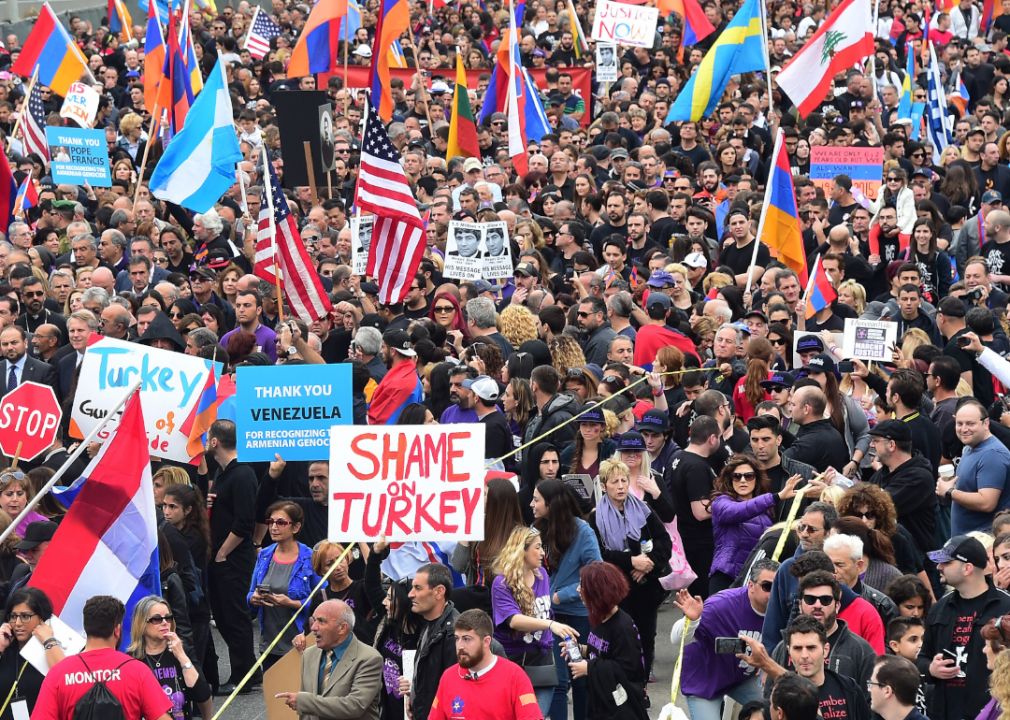
EDERIC J. BROWN/AFP via Getty Images
2015: Armenian March for Justice
A march of more than 130,000 protesters, which stretched for 6 miles from the Little Armenia neighborhood of Hollywood to Los Angeles’ Turkish consulate, took place on April 24, 2015, in demand that Turkey officially recognize the Armenian Genocide. While 32 countries officially recognize the Armenian Genocide, Turkey and its ally Azerbaijan continue to deny the systemic mass murder of 1.5 million Armenians.
[Pictured: Tens of thousands of Armenian Americans take to the streets of Los Angeles on April 24, 2015, to march for justice and in memory of victims of the Armenian genocide.]
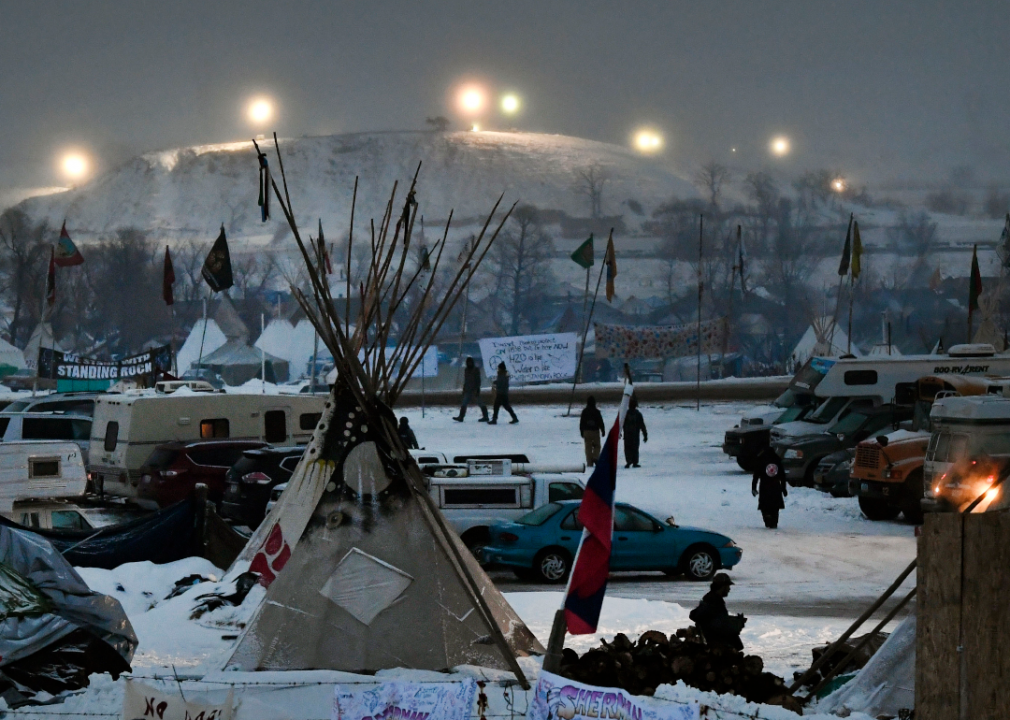
Helen H. Richardson/The Denver Post via Getty Images
2016: Dakota Access Pipeline protests
Thousands of Native Americans and their allies gathered in rural Cannon Ball, North Dakota, to protest against the Dakota Access pipeline in early 2016. Activists feared that the oil pipeline would contaminate the Missouri River water supply and threaten sacred native land. The demonstrations motivated President Barack Obama’s administration to deny an easement for pipeline construction, which was reversed by President Donald Trump weeks later.
[Pictured: Flood lights from the North Dakota national guard light up the night sky amid the teepees, tents, RV, and cars at Oceti Sakowin Camp on the edge of the Standing Rock Sioux Reservation on Dec. 1, 2016, outside Cannon Ball.]
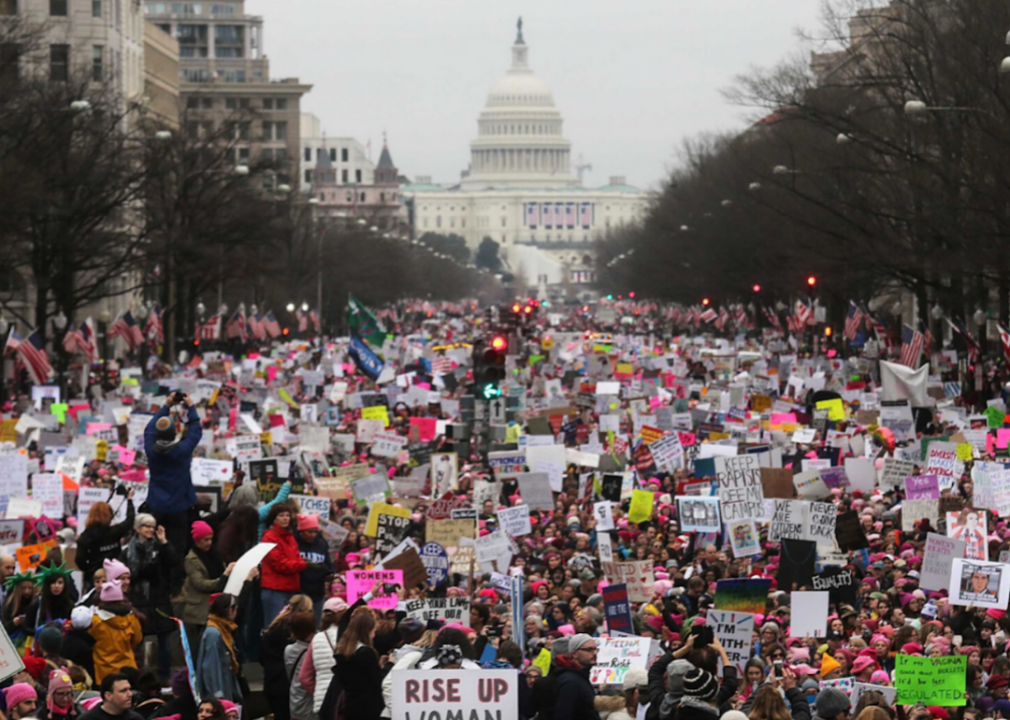
Mario Tama // Getty Images
2017: The Women’s March on Washington
Nearly half a million people—mostly women—marched down the streets of Washington D.C. on Jan. 21, 2017, to show support for women’s rights and demonstrate against newly elected President Donald Trump. Millions of other people took part in similar protests around the world that day.
[Pictured: Protesters walk during the Women’s March on Washington on Jan. 21, 2017, in Washington D.C.]
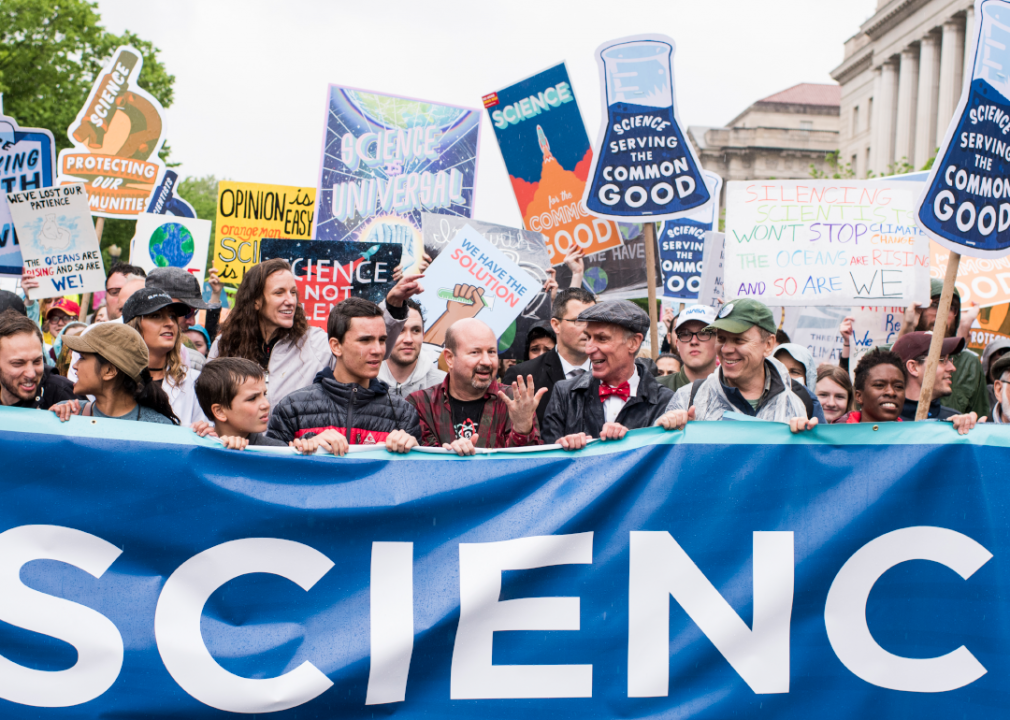
Bill Clark/CQ Roll Call // Getty Images
2017: The March for Science
Around 100,000 protesters took to the streets of Washington D.C. on Earth Day 2017 to call on politicians to use science when making policy decisions on public health and climate change. Similar demonstrations took place in more than 600 other cities across the globe, bringing the total attendance at The March for Science to more than 1 million people.
[Pictured: Marchers, including Bill Nye the Science Guy, center, lead the Science March down Constitution Avenue in Washington on Earth Day, April 22, 2017.]
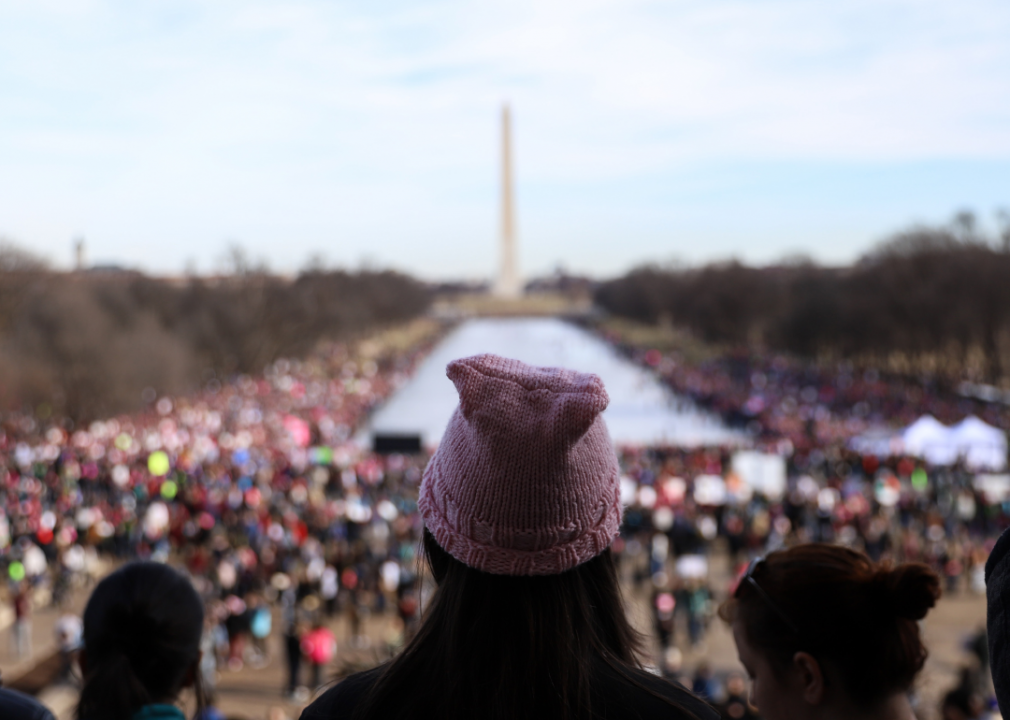
Alex Wroblewski // Getty Images
2018: Women’s March
Re-energized from the #MeToo movement, women’s groups around the country organized mass rallies on Jan. 20, 2018, around the anniversary of the women’s march of 2017. The events drew millions of attendees, including more than 200,000 marchers in New York City and an estimated 600,000 people in Los Angeles, calling for an end to the oppression of women.
[Pictured: People gather at the Lincoln Memorial reflecting pool to rally before the Women’s March on Jan. 20, 2018, in Washington D.C.]
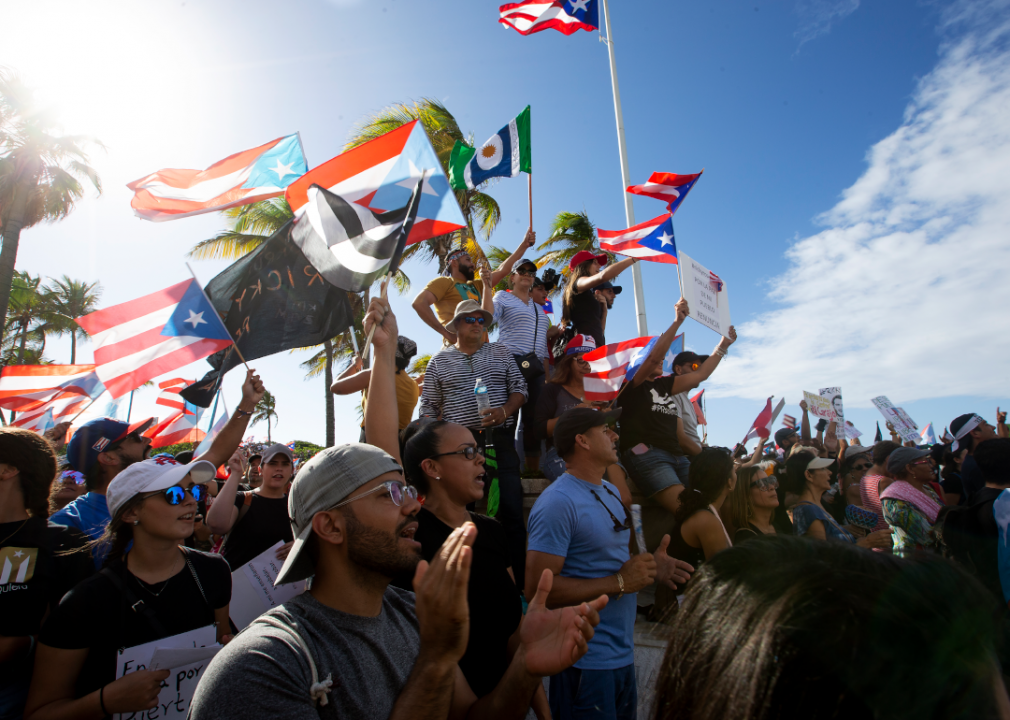
Jose Jimenez // Getty Images
2019: Telegramgate protests in Puerto Rico
Mass protests arose in Puerto Rico in July 2019 in response to Telegramgate, a political scandal in which hundreds of racist and homophobic messages sent by former Gov. Ricardo Rosselló via the app Telegram were leaked to the public. Around a million people protested on July 17 and again on July 22, shutting down a major highway. While Rosselló initially refused to step down, he eventually resigned several weeks later.
[Pictured: Demonstrators protest against Ricardo Rossello in front of the Capitol building on July 17, 2019, in Old San Juan, Puerto Rico.]
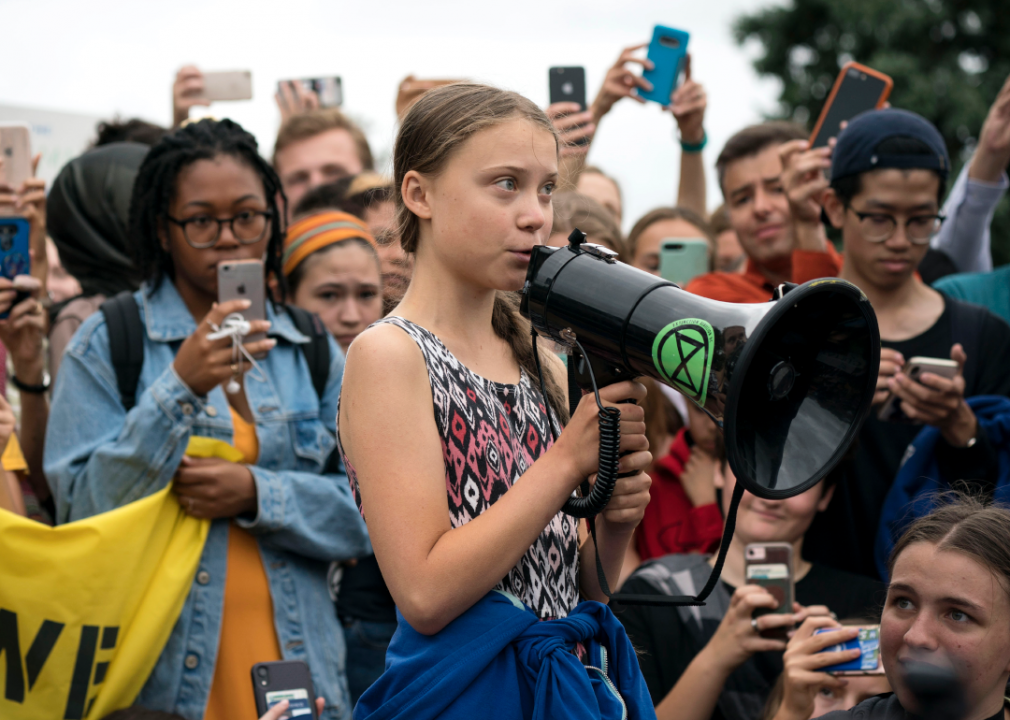
Sarah Silbiger // Getty Images
2019: September 2019 climate strike
Inspired by 17-year-old climate change activist Greta Thunberg, more than 1,000 strike events occurred in the United States in late September 2019 calling for a Green New Deal, respect for native land, environmental justice, sustainable agriculture, and protection of biodiversity. Public school students in New York City, Boston, Chicago, and other cities were given permission to skip school to participate in the event, and some 250,000 people attended New York City rallies. The strike would show politicians and the media that youth were united in support of measures to fight climate change.
[Pictured: Greta Thunberg delivers remarks surrounded by student environmental advocates in Washington D.C. ahead of the Global Climate Strike on Sept. 20.]
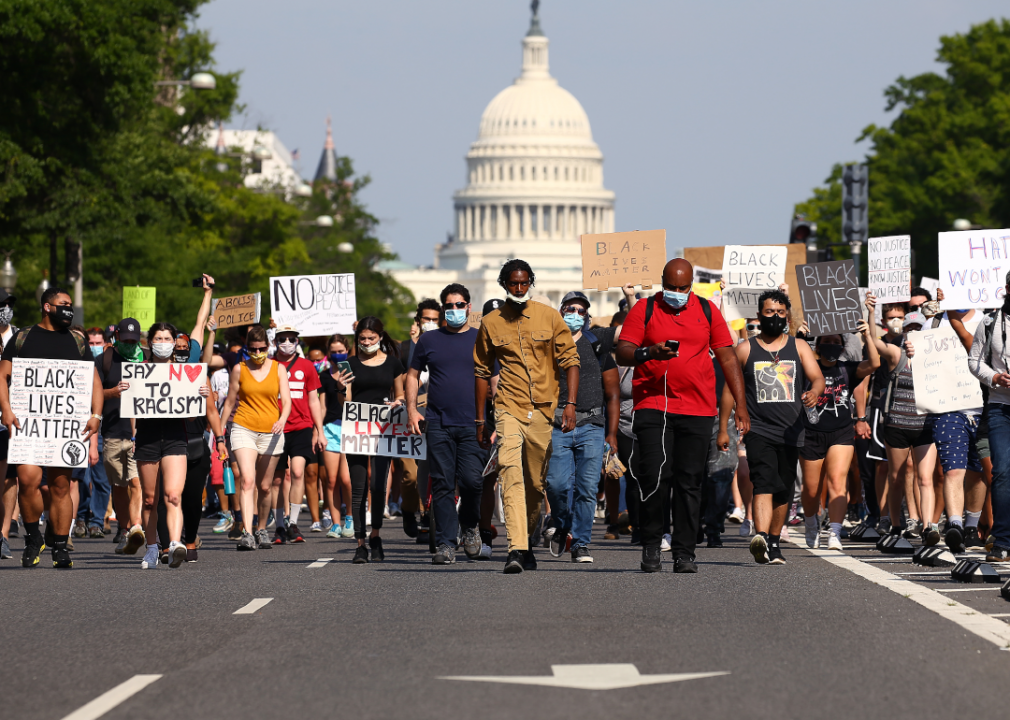
Tasos Katopodis // Getty Images
2020: Black Lives Matter
More than 450 protests against police brutality and institutional racism happened throughout the United States in late May and June after the death of George Floyd, a Black man who was killed when a white Minneapolis police officer, Derek Chauvin, kneeled on his neck for 8 minutes and 46 seconds. Solidarity protests erupted around the world, as well. The demonstrations sparked widespread dialogue about defunding or reforming the police.
[Pictured: Demonstrators march down Pennsylvania Avenue in Washington D.C. on June 3 during a protest against police brutality and the death of George Floyd.]-
You may also like: Most lopsided state legislatures in America